Summary of February itinerary in Japan (Hyogo, Tottori, Shimane trip)
I traveled to Hyogo, Tottori, and Shimane prefectures from Wednesday, February 23rd to Sunday, February 27th. I was able to eat a lot of seasonal fish and shellfish and local dishes, and I was able to visit wonderful tourist destinations such as national treasures and national important cultural properties on this trip. Since this trip was mainly on the Sea of Japan side of Hyogo, Tottori, and Shimane prefectures, I was able to enjoy the fresh seafood of the Sea of Japan such as live snow crab. In addition, I was able to fully eat food of the mountains such as “Botan nabe (wild boar meat hot pot)”. This is the February Japanese itinerary that I highly recommend to everyone. Here is a summary of this trip and some notes.
I will comment repeatedly every time, but this itinerary was also created with the purpose of “eating out seasonal fish and shellfish and local dishes.” Food is the highest priority, and tourist destinations are the second priority. However, we aimed to visit as many tourist spots as possible, such as national treasures and national important cultural properties.
Table of contents
1.”100 best of local dishes” and “Local dishes loved by the nation” by this itinerary in Japan
2. Seasonal “PRIDE FISH” by this itinerary in Japan
3. Travel precautions (local trains) for itinerary in Japan
5. February 23 (Wednesday) Day 1
6. February 24 (Thursday) Day 2
8. February 26 (Saturday) Day 4
1.”100 best of local dishes” and “Local dishes loved by the nation” by this itinerary in Japan
Hyogo Prefecture: Botan nabe
We can eat “Botan nabe (Wild Boar Hotpot)” all year round if we serve frozen boar meat. However, the season for “Botan nabe” is usually from November 15th to March 15th (in the case of 2021 to 2022), which is the hunting period for wild boars. You can eat raw boar meat during the wild boar hunting period. Along with Mt. Amagi in Shizuoka Prefecture and Gujo Hachiman in Gifu Prefecture, the Tanba Sasayama region is also famous nationwide as the “three major hunting grounds in Japan” for wild boars.
It is said that “Botan nabe” started when wild boar meat, which was stationed in Sasayama-cho, Hyogo prefecture in the Meiji era, was put into miso soup by the former Japanese Army. In other words, the Tanba Sasayama region is the origin of “Botan nabe”. The wild boar of Tanba Sasayama eats nuts such as Tanba chestnuts, Tanba matsutake mushrooms, and grains, so it is not greasy and is very delicious.
The fact that only “Botan nabe” from Hyogo prefecture is selected for wild boar meat in the “100 best of local dishes” nationwide proves the deliciousness of wild boar meat from Hyogo prefecture.
According to the official tourist website of Tanba Sasayama City, “Botan nabe” is derived from the fact that “boar” was replaced with “Botan (peony)” in the Edo period when the common people were prohibited from eating meat. Similarly, “horse” was called “Sakura” and “deer” was called “Momiji (maple)”.
I had “Botan nabe” at “Botan Tei”.I ordered a “mixed hot pot” containing half of the special loin meat and half of the special rib meat at “Botan-tei”. During the hunting season, the wild boar meat of “Botan-tei” was chilled and chilled while keeping the freshness of the raw meat to bring out the flavor of the wild boar meat.
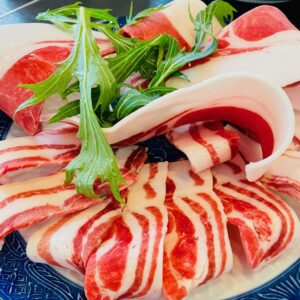
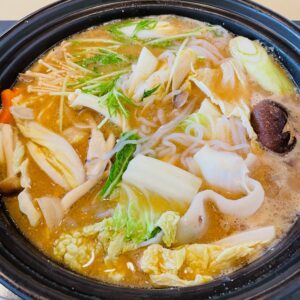


In a word, the taste of “Botan nabe” was “excellent”. “Botan nabe”, which uses miso mixed with chestnuts and contains a large amount of wild boar meat, vegetables, shiitake mushrooms, tofu, etc., exudes each other’s taste into the pot and becomes an exquisite taste.
In addition to “Botan nabe”, “Ikanago (Japanese sand lance) no Kugi-Ni” is selected as one of the “100 best of local dishes” in Hyogo Prefecture. The opening date for the “Ikanago” fishing in 2022 (Harimanada, Osaka Bay) was March 1.
There are “Akashi-yaki” and “Kobe beef steak” in “Local dishes loved by the nation“. I ate “Akashi-yaki” on my trip in October 2021. On the other hand, I couldn’t eat “Kobe beef steak”, but I could eat “Tajima beef steak”. By the way, Kobe beef is beef carefully selected from Tajima beef at the time of shipment. Therefore, “Tajima beef steak” is almost the same as “Kobe beef steak”.
Tottori Prefecture: Ago-noyaki
I had “Ago-noyaki” with ekiben on the train from Yonago station to Shinji station.
“Ago-noyaki” is a dish that is seasoned with surimi of “flying fish” and squeezed into a stick to bake. The raw materials for ordinary chikuwa are Alaska pollack, sharks, and atka mackerel, but “Ago-noyaki” is made from flying fish. Originally, the difference between “Ago-noyaki” and “Ago-chikuwa” is the size. “Ago-noyaki” is said to be 70 cm long and weigh more than 1 kg if it is large. However, the souvenir “Ago-noyaki” I bought was about 20 cm long, although it was larger than the chikuwa. However, it was very voluminous and difficult to eat.
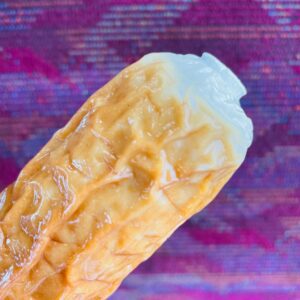

This time, I had the cold “Ago-noyaki” by biting it, but if I have a chance, I would like to eat the freshly made hot “Ago-noyaki” in slices.
In Tottori prefecture, “Local dishes loved by the nation” are not selected. However, 27 kinds of dishes have been selected as “Our Regional Cuisines” selected by the Ministry of Agriculture, Forestry and Fisheries. Among them, “Ago-noyaki” overlaps with “100 best of local dishes”. I had “Daisen Okowa” and “Tofu Chikuwa” on the train from Yonago Station to Shinji Station, and “Rakkyo-zuke” at “Washoku Izakaya Shunmon” in Yonago City.



“Daisen Okowa” is a vegetarian dish that was served by people who trained in Daisen, and the Okowa of Daisenji has spread to the home. Okowa is glutinous rice steamed with some ingredient. It had a gentle taste with a soy sauce flavor containing chestnuts. It has been selected as “Our Regional Cuisines” by the Ministry of Agriculture, Forestry and Fisheries.
As the name suggests, “Tofu Chikuwa” is a chikuwa made from tofu. It is a unique processed food found in Tottori prefecture in Japan. It is made by mixing firm tofu and minced white fish at a ratio of about 7: 3 and steaming it. Since the proportion of tofu is high, the color is almost pure white. It was tofu, so it was very delicious when eaten with soy sauce. I like tofu, so I prefer “Tofu Chikuwa” to ordinary chikuwa.
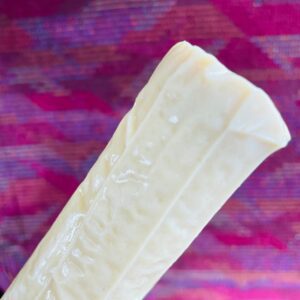

Tottori Prefecture has the highest production of scallions in Japan (2019). “Rakkyo-zuke” from “Washoku Izakaya Shunmon” was very delicious.


In Tottori prefecture, I ate “Horumon-soba” and “beef bone ramen” which are local gourmet foods in addition to “100 best of local dishes” , “Local dishes loved by the nation” and “Our Regional Cuisines”.
Horumon-soba is a yakisoba with beef offal that is loved by locals in the eastern part of Tottori prefecture such as Tottori City. I had Horumon-soba at Goen in Tottori city. The Horumon-soba I ate was a very delicious yakisoba with the noodles, offals and sauce entwined exquisitely.






Beef bone ramen is a ramen that takes soup based on beef bones. Tottori Prefecture is a region where livestock farming in Daisen, especially cattle production, is high. The beginning of beef bone ramen is to make ramen by using the surplus beef bones as soup.



Shimane Prefecture: Izumo soba
I had “Izumo soba” at “Ippuku” near Matsue Station. “Izumo soba” is one of the three major soba noodles in Japan (the other two are Wanko soba and Togakushi soba). It is said that “Izumo soba” began when Naomasa Matsudaira, the first feudal lord of the Matsue domain, brought a soba craftsman from Shinano when he changed his country from the Matsumoto domain in Shinano province. Warigo soba is a common way to eat Izumo soba, which is made by serving boiled soba in a round lacquer ware.
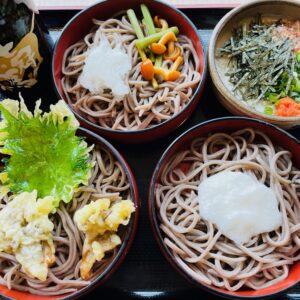


“Izumo soba” of “Ippuku” was very delicious soba. It was a soba that goes well with the local sake “Seven Crown Horse” in Shimane Prefecture.
In Shimane prefecture, as in Tottori prefecture, “Local dishes loved by the nation” are not selected. Since I didn’t stay in Shimane prefecture this time, I could hardly eat any food from Shimane prefecture other than “Izumo soba”.
I only ate “Hamada no Akaten” at “Washoku Izakaya Shunmon” in Yonago City. “Hamada no Akaten” is a local food in Hamada City, Shimane Prefecture. Akaten is a kamaboko made by adding a red color to the paste to make it spicy. You can enjoy the crispy texture as it is fried with bread crumbs.


2. Seasonal “PRIDE FISH” by this itinerary in Japan
Hyogo Prefecture : None
I couldn’t eat “PRIDE FISH” in Hyogo prefecture. However, although it is not included in “PRIDE FISH”, I was able to eat seasonal “live snow crab” in Toyooka City. “Matsuba crab” is the name of “snow crab” in Hyogo prefecture and Sanin region.
The ranking of catch snow crabs like below. Hyogo prefecture is ranked 1st, Tottori prefecture is 2nd, Fukui prefecture is 3rd, 4th Hokkaido, and 5th Ishikawa prefecture (2020). In Fukui prefecture, snow crab is called “Echizen crab”, and in Ishikawa prefecture, it is called “Kano crab”.
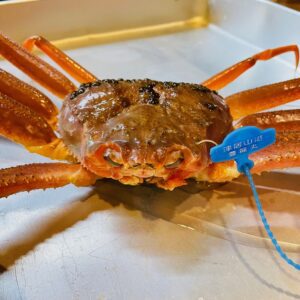


The “live snow crab” I ate this time is a brand crab landed at Tsuiyama Port in Hyogo Prefecture. The plastic blue tag with the name of Tsuiyama Port is the certificate of origin. Tsuiyama Port is a fishing port located about 15km north of Toyooka Station.
I think the most delicious way to eat “live snow crab” is sashimi. When you eat it with sashimi, you can feel the sweet taste of “live snow crab” more clearly, and you will be surprised at its deliciousness. Boiled snow crabs often use frozen crabs, so I think it’s a waste to eat boiled snow crabs during the season.



Next, the grilled snow crab came out. Grilled snow crab is also fragrant and delicious, but it does not come true to the deliciousness of sashimi.
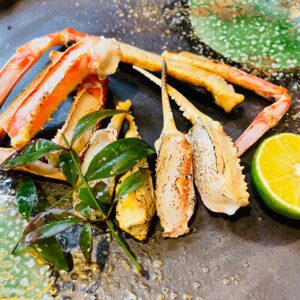


Tottori Prefecture: Snow crab, Japanese sandfish, Spanish mackerel
I was able to eat three types of “PRIDE FISH”, Snow crab (season: November-March), Japanese sandfish (season: March-May) and Spanish mackerel (season: October to March) in Tottori prefecture.
I was able to eat Snow crab, Japanese sandfish and Spanish mackerel in Tottori City and Spanish mackerel in Yonago City.
The “live snow crab” of “Aji-goyomi Anbe” in Tottori City was an incredibly good price of Yen 4,500 per crab. When I asked the shop owner, it was a cash purchase, so it was said that they could be purchased at a large discount. I ate “live snow crab” with sashimi and grilled.



Grilled yaki crab is a way of grilling and eating by yourself. It was the best luxury to bake and eat crab miso in the shell. The owner taught me how to eat crab sashimi with the hot crab miso. When I actually tried it, this was also the best. It was too luxurious to eat.






I had Japanese sandfish sashimi for the first time in my life. Usually, Japanese sandfish are often baked and eaten, and I also ate grilled Japanese sandfish during my trip to Akita in December and Yamagata in January. This time I challenged the sashimi of Japanese sandfish. It was very greasy and very delicious.



Tottori Prefecture is the second largest catch of Japanese sandfish (Hyogo Prefecture is the first) in 2020.
Compared to the sashimi of Spanish mackerel, the Nanbanzuke (marinated in a spicy sauce) of Spanish mackerel and white onions lacked impact, but they tasted above average. On the day I went, there was no sashimi of Spanish mackerel in the restaurant, so I ordered Nanbanzuke.
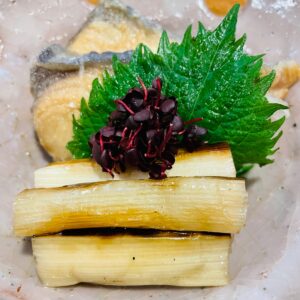


The specialty sashimi platter ordered at “Washoku Izakaya Shunmon” in Yonago City included shiro-ika, yellowtail and sagoshi. Sagoshi is a young Spanish mackerel. It was delicious.
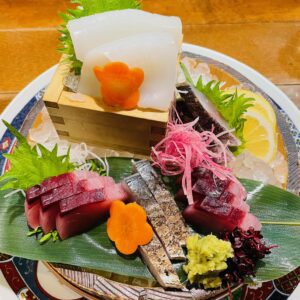


Although it was not selected as a “PRIDE FISH”, I was able to eat the seasonal (September-May) “Mosabi (black small shrimp)” at the “Ajigoyomi Anbe”. It is a phantom shrimp that can only be tasted locally because its freshness deteriorates quickly and it is difficult to ship it to a long distance. It had a sweeter taste and more elastic texture than the northern shrimp, and it was a delicious taste that completely surpassed the sashimi of the northern shrimp.



Shimane: None
I didn’t stay in Shimane prefecture this time, so I couldn’t eat “PRIDE FISH” in Shimane prefecture. However, the winter “PRIDE FISH” in Shimane Prefecture is the Oki Snow crab (season: November-February), so I am satisfied with the Snow crab I ate in Hyogo and Tottori prefectures this time.
“PRIDE FISH” is selected by Japan Fisheries Co-operative.
3. Travel precautions (local trains) for itinerary in Japan
I write the same thing every time, but it’s important, so I repeat it. This time as well, the rule of travel is an environment-friendly trip that uses only public transportation including rental bicycles.
Again, this is a reconfirmation, but traveling by public transport has far less CO2 emissions than traveling by car. For example, according to data from the Ministry of Land, Infrastructure, Transport and Tourism, CO2 emissions when one person travels 1 km are 130 g for automobiles, 98 g for aircraft (75% for automobiles), 57 g for buses (44% for automobiles), and 17 g for railways (13% for automobiles).
It was difficult to understand how to get on and off the one-man operated train this time as well. “JR Sanin Line” (I ride from Kinosaki Onsen Station to Tottori Station and from Shinji Station to Matsue Station), “JR Inbi Line” (I ride from Tsunoi Station to Tottori Station) were a one-man operated train.
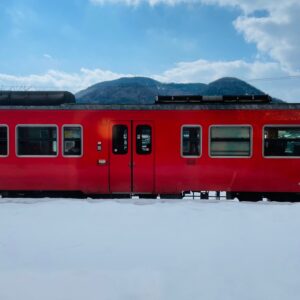

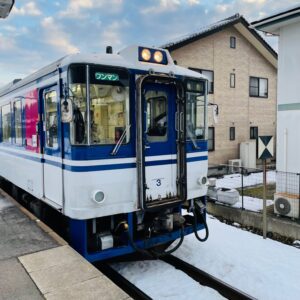

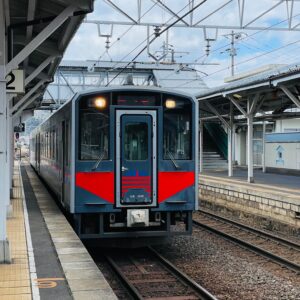

When getting on and off a one-man operated train, you need to press a button to open the door. When you get on the train, take a numbered ticket, and when you get off, put the numbered ticket and money in the fare box and get off.
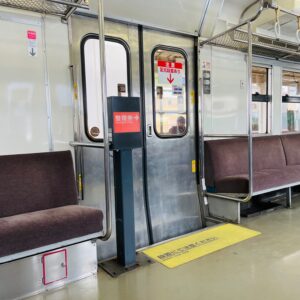

There was a poster in the car about how to get on and off, but it was only in Japanese. Railroad operators and tourist associations should be responsible for providing guidance in foreign languages.
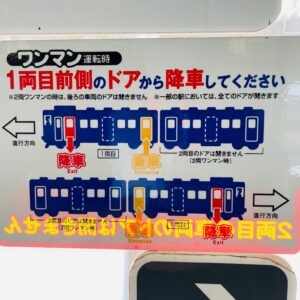

In the case of a one-man operated train, it is safe to always get on the first car. Be sure to remember the train boarding / alighting rules when traveling in rural areas of Japan. However, it depends on the railway operator whether you ride from the front door or the rear door of the first car.
Tottori Station doesn’t have an automatic ticket gate, although it is the station where the prefectural office is located. Please note that many stations on the JR Sanin Line are not automatic ticket gates.
Please see the detailed notes written on each travel day.
4. Travel in a light style
Again, I sent my clothes and power cord to my accommodation in advance for this trip, and enjoyed the “luggage free trip” every day. After all, it is very easy to travel in a light style like taking a walk. Being able to act immediately after arriving by train or plane is important for effective use of time. In particular, I changed the accommodation location for all four nights this time, so I think it would have been difficult if I had to carry my luggage with me.
Toyooka City and Tottori City were snowy roads this time. When it snows, transporting the suitcase becomes many times more difficult than on a road without snow like this time. I want you to travel as “luggage-free trip” in winter. Again, on the last day of the trip, I sent the clothes I wore during the trip to the laundry agent and did not have to do the laundry. I want everyone to experience the comfort of “luggage-free trip”.
5. February 23 (Wednesday) Day 1
Tourist spots
From Wednesday, February 23, I traveled to Hyogo, Tottori, and Shimane prefectures for 4 nights and 5 days. This time as well, I sent my luggage to my travel destination and enjoyed the “luggage-free trip”. First, I flew from Haneda Airport to Itami Airport and headed for Tamba Sasayama City.
After arriving in Tanba Sasayama City, I had the most delicious lunch at “Botan Tei” and went for a walk in the city. A part of Tamba Sasayama City has been selected as a National Important Preservation Districts for Groups of Traditional Buildings as a Shinoyama traditional buildings preservation area. We can walk around almost every tourist destination in the city. It is a wonderful city where we can take a walk while enjoying the old streets.
The first “Taisho Romankan” I visited was the former Shinoyama Town Hall, which was built in 1923 (Taisho 12). It is a beautiful building with a Taisho Romanesque atmosphere.


Sasayama Castle, which is very close to the Taisho Romankan, was built in 1609 by Ieyasu Tokugawa, who ordered 20 Daimyo. It has been selected as one of the “100 Fine Castles of Japan” selected by the Japan Castle Association.
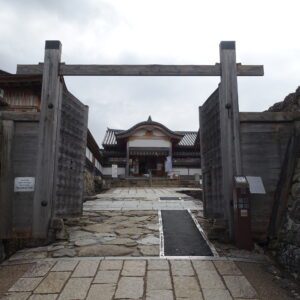

Sasayama Castle Oshoin was the core building of Sasayama Castle without a castle tower. Oshoin is a very large wooden house building, and is comparable in scale to the Ninomaru Palace (national treasure) of Nijo Castle in Kyoto. It has a floor area of 739.33 square meters and a building height of 12.88 meters.


Sasayama Castle Oshoin was burnt down in 1944, and the current building was rebuilt in 2002. You can see the inside of Sasayama Castle Oshoin. It’s very spectacular.




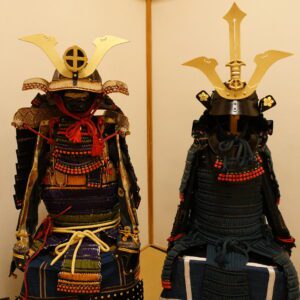

There is also Aoyama Shrine in Sasayama Castle, which enshrines Tadatoshi and Tadahiro of the feudal lord Aoyama clan as deities. The Aoyama family was the family of the Tokugawa Fudai Daimyo, who was a member of shogun’s council of elders.
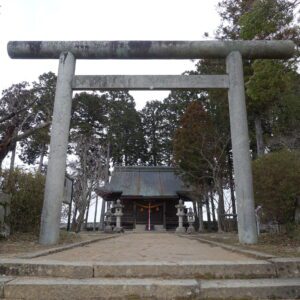

The Aoyama Historical Village & Dekanshokan museum is very close to the Sasayama Castle Ruins. The former Sawai family Nagaya-mon (Nagaya gate) at the entrance is a designated cultural property of Tanba Sasayama City.
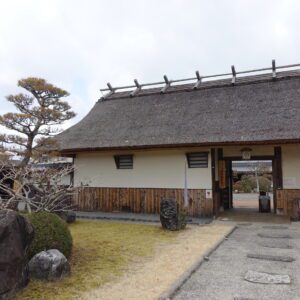

The Keiensha, which was built at Meiji-era as the villa of the Aoyama clan, the lord of the Sasayama clan, is a very simple building as the villa of the former daimyo.
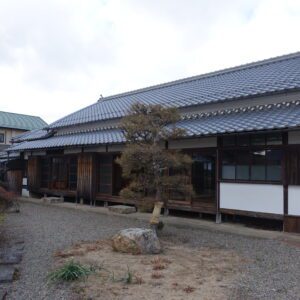



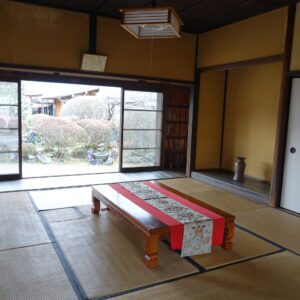

The Dekanshokan museum is a facility that introduces the charm of the folk song “Dekansho-bushi”, which is sung as a nationally famous Bon Odori song, and Tanba Sasayama. In 2015, “Tanba Sasayama Dekansho Bushi -Memories in a folk song-” was selected as one of the first 18 Japanese heritage sites by the Agency for Cultural Affairs.


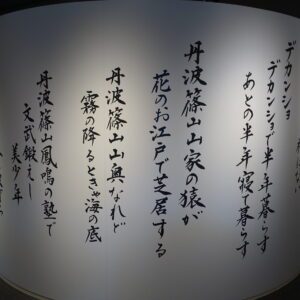

Okachimachi in Tamba-Sasayama City is a group of samurai residences that retain the remnants of the Edo period.
The Anma Family was a vassal of Mr. Aoyama, the lord of the Sasayama clan. The Anma Family Residence is a typical late Edo period samurai residence with wooden and thatched roofs.
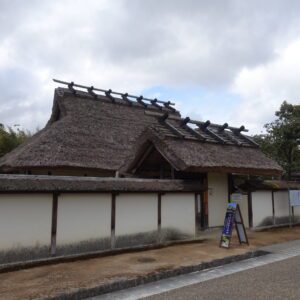

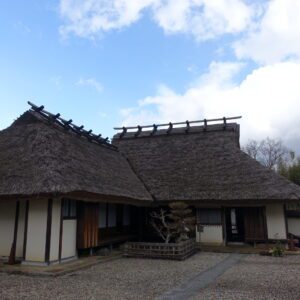

Inside the Anma family residence, there were various samurai exhibits such as armor, which was impressive.
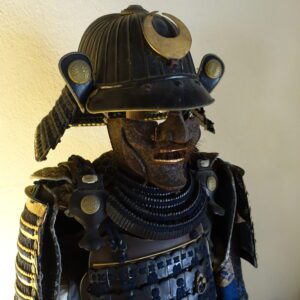

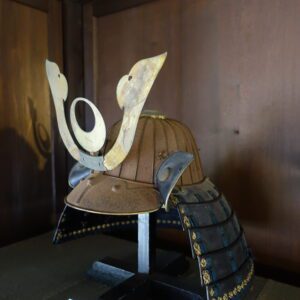

The Inahata doll exhibited in the Yasuma family residence is an important intangible cultural property of Tanba City.
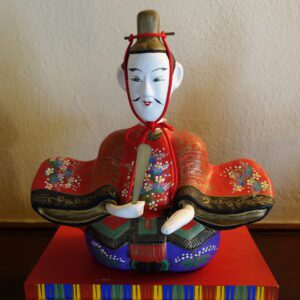

The Sato family residence, which is lined with the Anma family residence, was open to the public. It is a house that has just been re-thatched. The landlord was a very friendly person and released various materials and armor. Nishiki-e and other items were so well preserved that I couldn’t believe they were privately owned, and I enjoyed watching them. Admission to the Sato family residence is free.
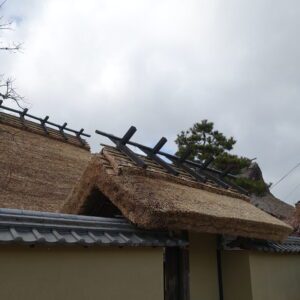

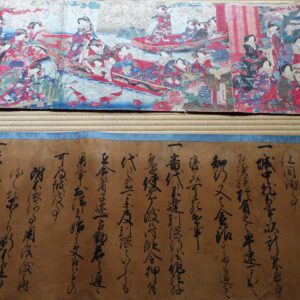

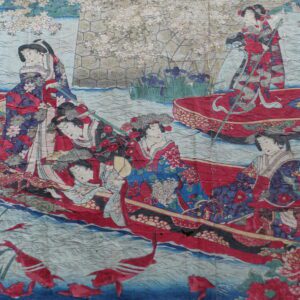



Sasayama merchant districts, located about a 5-minute walk from Sasayama samurai districts, is a row of merchant houses that retains the remnants of the Edo period on a street of about 600m. The Sasayama samurai districts had only a few samurai residences rather than the entire street. However, in the Sasayama merchant districts, the merchant residences lined up neatly, and I felt it was more fun to take a walk.
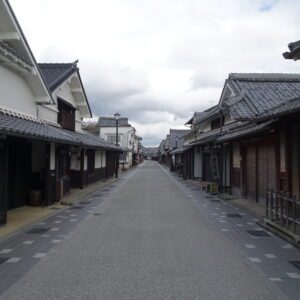

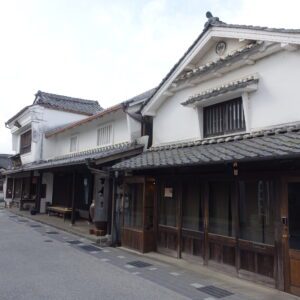

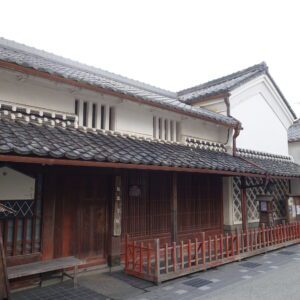

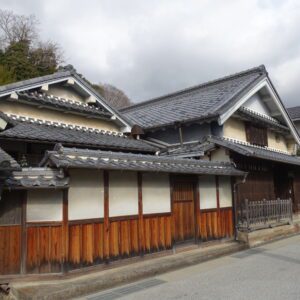

Ojiyama Makekirai Inari is an Inari shrine located about a 5-minute walk from the Sasayama merchant districts. If you go up about 200 steps from the first torii gate, you will find the Inari main shrine. There are 44 red torii gates.
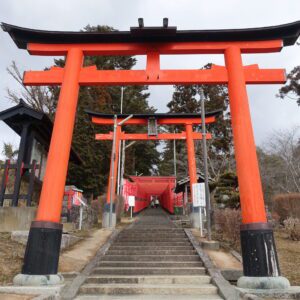

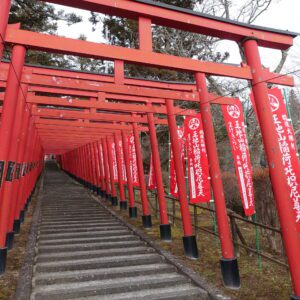

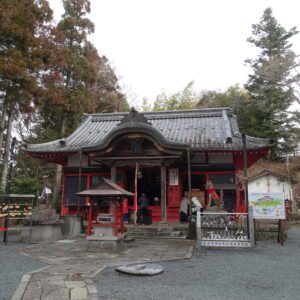

Tanba Sasayama Municipal Museum of History is a former Sasayama Court. The Sasayama Court was established in 1870 (Meiji 3) using the building of the Sasayama Domain Office. It is one of the oldest wooden courts in Japan.
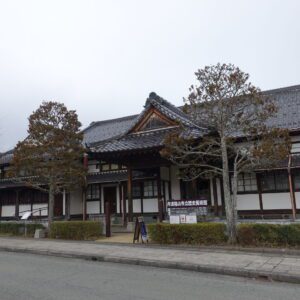

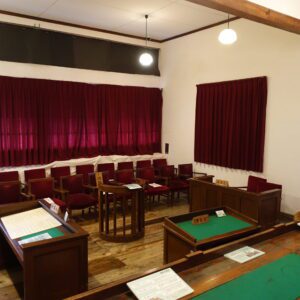

Kasuga Shrine, located just off the Tanba Sasayama City Historical Museum, was separated from Kasuga Taisha Shrine in Nara about 1,000 years ago. In 1609, it was relocated to its present location for the construction of Sasayama Castle.
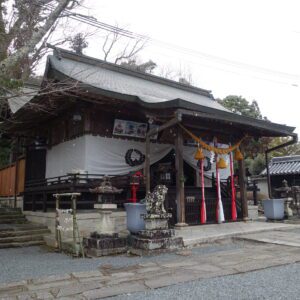

The Noh stage of Kasuga Shrine is a national important cultural property. The Noh stage was dedicated in 1861 by Tadanaga Aoyama, the lord of the Shinoyama feudal lord who was a Noh lover. It is a pity that we cannot see the Noh stage because it is closed by the shutters except when the Noh dedication is held twice a year (Yuan Dynasty Noh of “Okina” on New Year’s Day, Kasuga Noh in Spring).
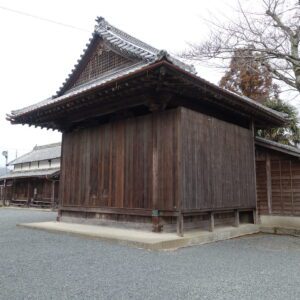

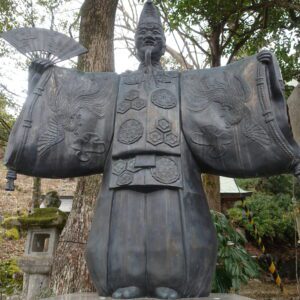

The “Kuroshinme” dedicated to the votive picture of horse of Kasuga Shrine is a designated cultural property of Tanba Sasayama City. This votive picture of horse was dedicated by Tadakuni Matsudaira, the lord of the Shinoyama feudal lord, in 1649, and is said to have been drawn by Naonobu Kano. There are many wonderful votive picture of horse, and I think it is worth visiting Kasuga Shrine just to go to the votive picture of horse.


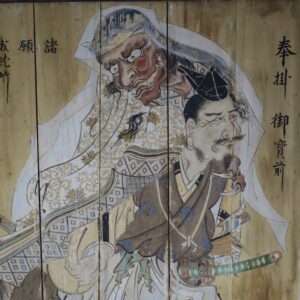

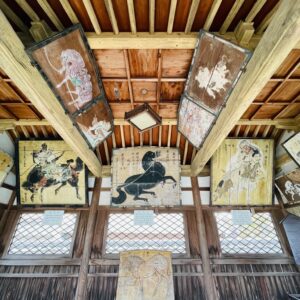

The Seiganji Temple was built by Hatano Hideharu, a military commander in Tanba, at the beginning of the Tensho era (1573-1592). The founder was Yoshitaka Ashikaga (a child of Yoshiteru Ashikaga, the 13th shogun of the Muromachi Shogunate). The tower gate, which retains the architectural style of the Muromachi period (1336 to 1573), is a designated cultural property of Tanba Sasayama. The tower gate was made by a combination method that does not use any nails.
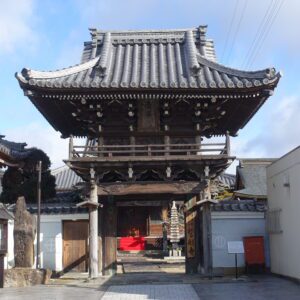

The hotel I stayed at in Tanba Sasayama is “Sasayama Castletown Hotel NIPPONIA“, a renovated old folk house hotel.
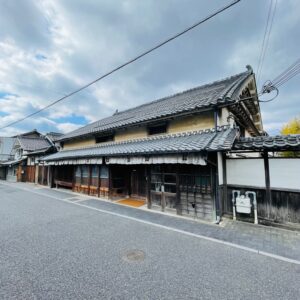

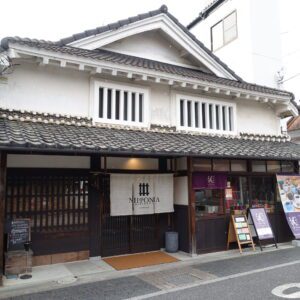

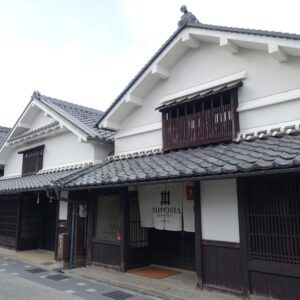

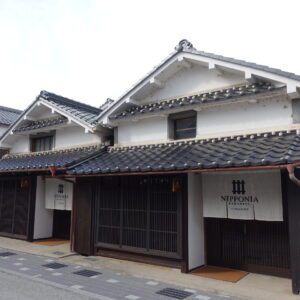

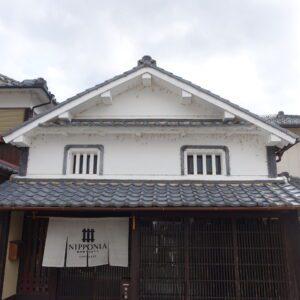

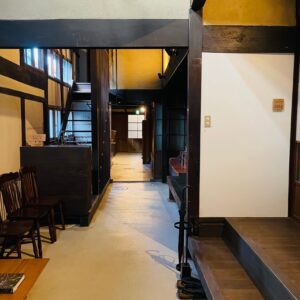

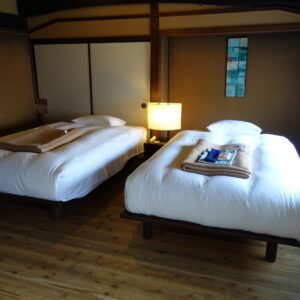

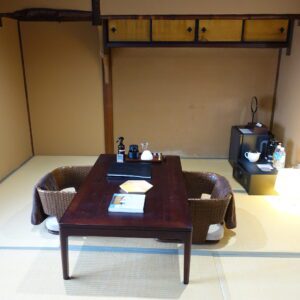

Meals
I had “Botan nabe (Wild Boar Hotpot)” at “Botan-Tei” as the first meal of this trip. To eat “Botan nabe” was the biggest reason to visit Tanba Sasayama this time. “Botan nabe” has been selected by the Ministry of Agriculture, Forestry and Fisheries as one of the “100 Best Local Cuisine” in Hyogo Prefecture.






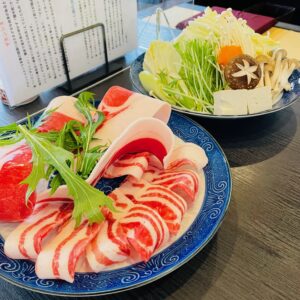

Houmei Sake Brewery is a long-established sake brewery founded in 1797. The building of the store was also very old and had a very nice atmosphere with high ceilings. Hina dolls were also displayed.
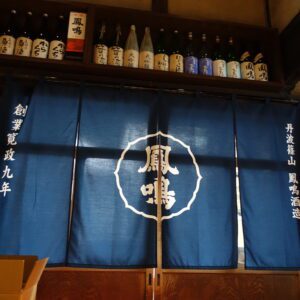



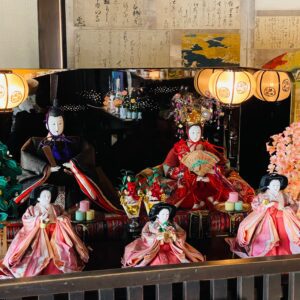

At Houmei Sake Brewery, I drank 5 kinds of drinks (Yen 660). Everything from Junmai Daiginjo Sake to Junmai Sake was very delicious. Moreover, all five types were large in quantity, and it was a nice sake set.
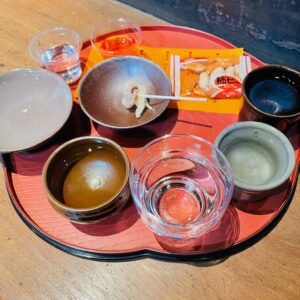

At Houmei Sake Brewery, I was able to tour the sake brewery. It was a wonderful sake brewery like a folk museum, and I felt like I had traveled back in time to the Edo period.
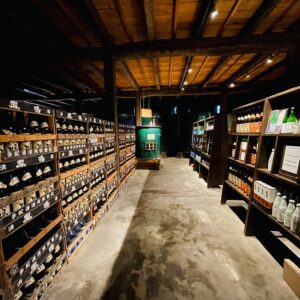

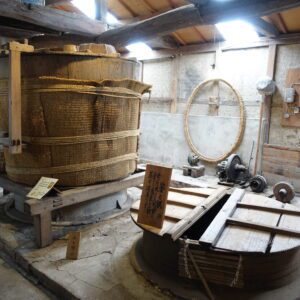

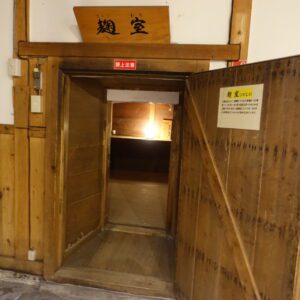

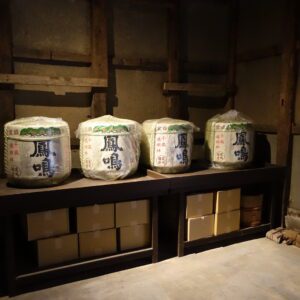

I had dinner at our accommodation, Sasayama Castletown Hotel NIPPONIA. It was an old folk house hotel, so the entrance of the restaurant had a nice atmosphere.


The dinner at Sasayama Castletown Hotel NIPPONIA was a French course. The first dish was “Seasonal Vegetable Gargouille”, which was very beautifully presented. “Gargouille” is a representative dish of the French 3-star restaurant “Michel Brass”.


Next, I had “Turnip Velouté”. Velouté is a soup made from white vegetables such as turnips, white onions, and onions. It was a delicious soup.
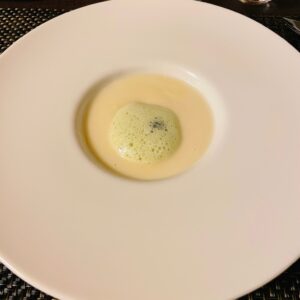

Next, I had “Grilled fresh fish (burdock accent, lees sauce)”. Especially, the fried burdock was delicious.
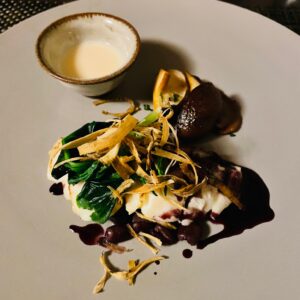

I had “Tajima beef roti” as the main dish. Roti is low-temperature roasted beef.
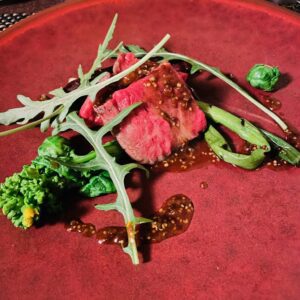

Important points
Sasayama Castletown Hotel NIPPONIA is a renovated old folk house, so the soundproofing was not good at all. It’s an old folk house, so it can’t be helped, but I think people who care about the sound will be quite concerned. Before staying at Sasayama Castletown Hotel NIPPONIA, you should understand that soundproofing is not very good.
Buses in Tanba Sasayama have often arrived earlier than the timetable. Buses usually lag behind the timetable, but in Tanba Sasayama, it’s better to arrive at the bus stop a little earlier.
6. February 24 (Thursday) Day 2
Tourist spots
The main purpose of Kaibara is to visit “Kaibara Hachiman Shrine”, a national important cultural property. It was my first visit to Kaibara. It was a fun city to walk around. When you go to Tanba Sasayama, I definitely want you to go to Kaibara.
First of all, I went to “Taiko Yagura”. “Taiko Yagura” was made around the same time with the Kaibara clan’s residence (1714).
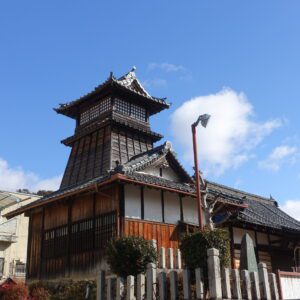

The main shrine (main shrine and worship hall) of “Kaibara Hachiman Shrine” is a national important cultural property. It is said that it was founded by enshrining Susanoo-no-Mikoto during the time of Emperor Jomei (629-641). The current shrine was rebuilt by Hideyoshi Hashiba (Toyotomi) in 1585. The architectural style of the shrine is valuable as a pioneer of “Gongen-zukuri”. “Gongen-zukuri” is a construction method in which the main shrine and the worship hall are integrated and a lower building called “Ishi-no-ma” is installed between them.
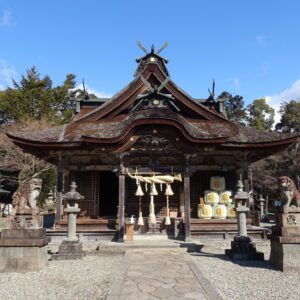



There is a three-storied pagoda in the precincts. There are only 18 towers in the shrine in Japan, and it tells the scenery at the time of Shinbutsu Shugo (Shinto-Buddhist syncretism) to the present day. The three-storied pagoda and the bell are important cultural properties designated by Hyogo Prefecture.
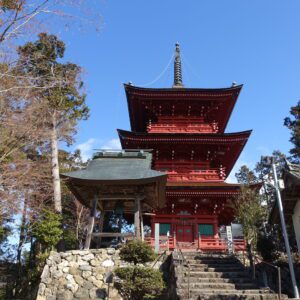

At the foot of Mt. Irifune, where “Kaibara Hachiman Shrine” is located, there is “Tanba City Hall Kaibara Branch”. “Tanba City Hall Kaibara Branch” is a two-story wooden Western-style building built in 1935 as the former Kaibara Town Hall.
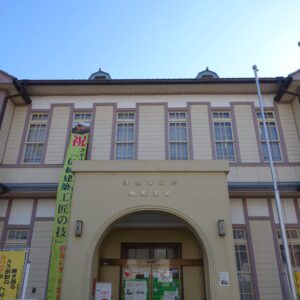

Right next to the Tanba City Hall Kaibara Branch, there is Great ZeIkova tree, a cultural property designated by Hyogo Prefecture and a natural monument. It is a giant tree estimated to be 1000 years old, and is also called a “tree root bridge” because it is a natural bridge with a length of 10 m.
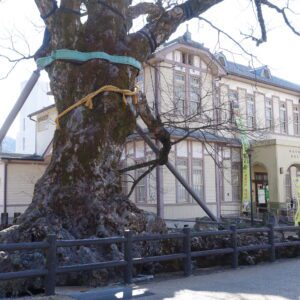

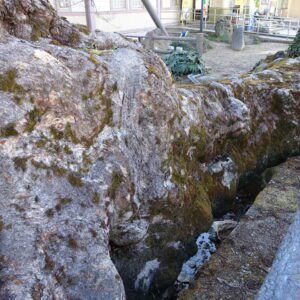

“Oda Shrine” is located near the Tanba City Hall Kaibara Branch, Great ZeIkova tree. “Oda Shrine” is enshrined as “Oda Gongen” by Nobukatsu Oda, the third feudal lord of the Kaibara domain. Nobukatsu is the younger brother of Nobunaga Oda and the grandson of Nobukane Oda, the first lord of the Kaibara domain. It’s a fairly simple shrine.


“Takeisao Shrine”, which is about a 5-minute walk from “Oda Shrine”, is a shrine whose deity is Nobunaga Oda. In Japan, there are only three “Takeisao Shrines” dedicated to Nobunaga Oda (Kyoto City, Kyoto Prefecture, Tendo City, Yamagata Prefecture). Like the Oda Shrine, it is a fairly simple shrine that makes us feel the rise and fall of the Oda clan, who once ruled Japan.
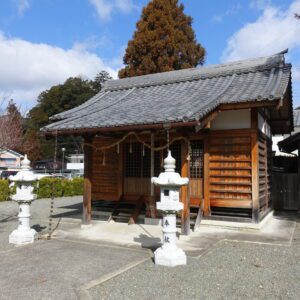

The Former Hikami Junior High School Building is a two-story wooden school building completed in 1885. It is an important tangible cultural property of Hyogo prefecture.
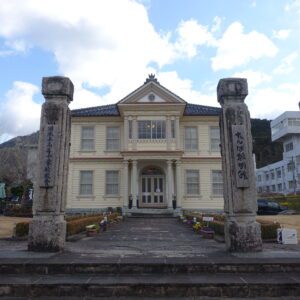

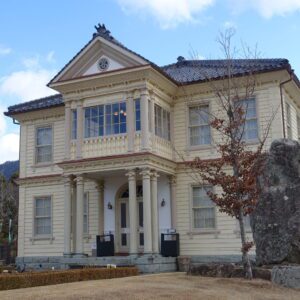

The Kaibara feudal lord Oda clan former residence Nagaya-mon was built in 1714. It is an Irimoya-zukuri. It is a cultural property designated by Hyogo Prefecture.
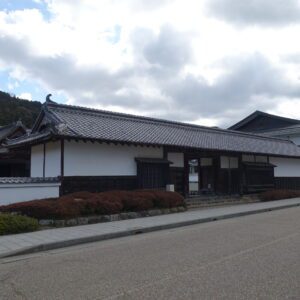

Passing through the Nagaya-mon, you will find the remains of the Kaibara Domain Jinya. The Kaibara Domain Jinya was built in 1714, just like the Nagaya-mon. It is designated as a national historic site as one of the few remains of Jinya in Japan.
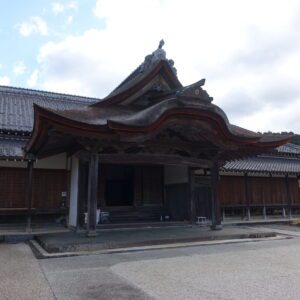

After enjoying a walk in Kaibara, I went to Izushi.
After arriving at Izushi, I had Izushi soba and went to the symbol of Izushi, Shinkoro.
Shinkoro was built in 1871 using waste materials such as the stone walls of the castle. It started operating as a clock tower on September 8, 1881. The Sapporo Clock Tower was in operation on August 12, 1881, so it is the second oldest clock tower in Japan. It is now a representative of the Toyooka City Izushi Traditional Buildings Preservation District (National Important Preservation Districts for Groups of Traditional Buildings). The origin of the Shinkoro is that it was a tower that hits the drum to inform the lord of the castle at the hour of the Dragon (7:00 to 9:00) at the beginning of construction.
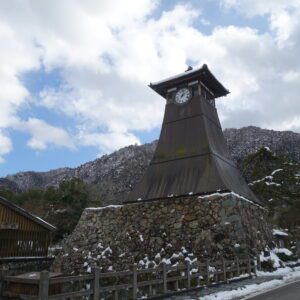

Izushi Castle is a few minutes walk from the Shinkoro. Izushi-jo is a castle that notified to the Tokugawa Shogunate in 1604 only the castle and pavilion as Izushi-jo at the foot of Arikoyama Castle.
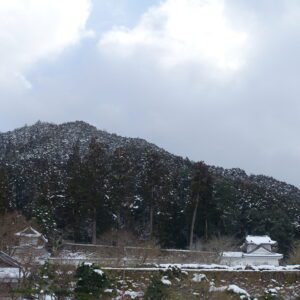

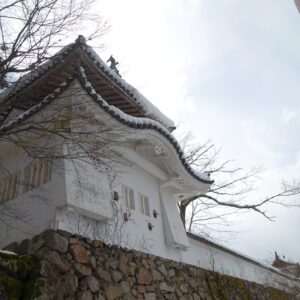

The stone wall of Arikoyama Castle still remains on the summit of Mt. Ariko. Arikoyama Castle was built in 1574 by Suketoyo Yamana, a leading guardian of the Muromachi period. In 1580, the castle fell under the attack of Hideyoshi Hashiba (Toyotomi).
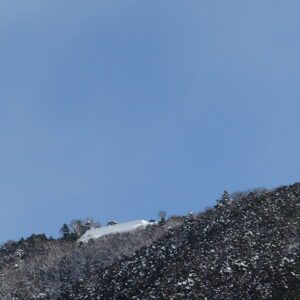

The Kannou-den at the site of Izushi Castle enshrines Hidehisa Sengoku, the first Sengoku clan who was the lord of the Izushi clan. Hidehisa Sengoku was the oldest vassal of Hideyoshi Toyotomi and served since he was a boy. Later, he also served the Tokugawa Shogun and became a Daimyo.
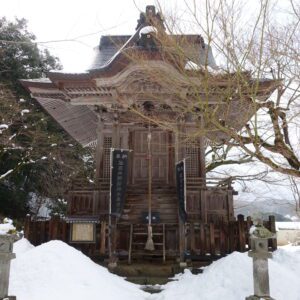

If you climb the east and west turrets and the Kannou-den on the stairs, you will find Arikoyama Inari Shrine. It was founded in 1604. There are 37 torii gates and 157 stone steps to the Shrine. It was snowy and it was difficult to climb up and down the stairs, but the shrine of Arikoyama Inari Shrine was wonderful and it was worth the effort to climb. The view of Izushi city from Arikoyama Inari Shrine was very beautiful.
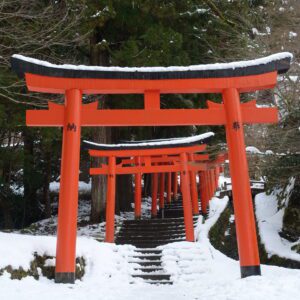

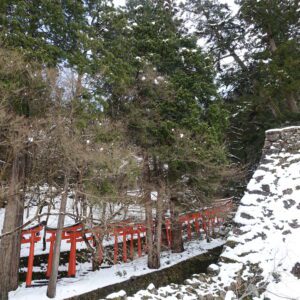

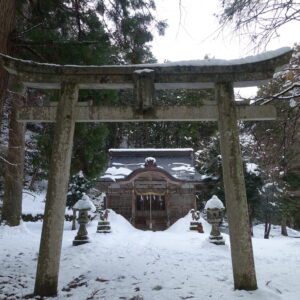

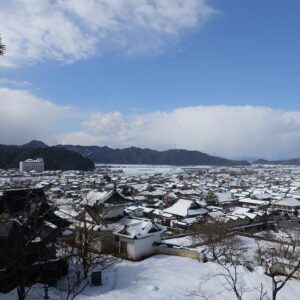

The Meiji-kan is a county office built in 1887, and is a two-story wooden retro Western-style building. It is the only Western-style building in the Meiji era that remains in Izushi.
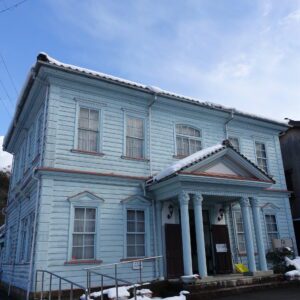

Sukyoji Temple was built in 1392. It is called Takuan-dera Temple because it is the hometown of Takuan Osho (Buddhist priest). Takuan Osho was born on December 1, 1573 in what is now Izushi-cho, Toyooka City, Hyogo Prefecture.
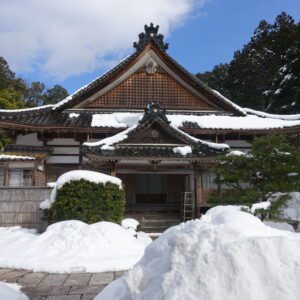

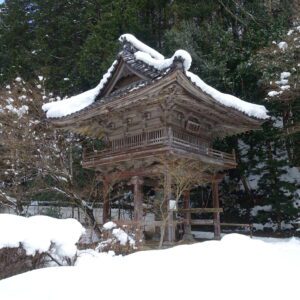

There is a memorial monument to Shonosuke Kawasaki (born in Izushi) at Ganjo-ji Temple, which is next to Sukyoji Temple. Shonosuke Kawasaki was the first husband of Yae Niijima, the main character of the NHK historical drama “Yae no Sakura”.
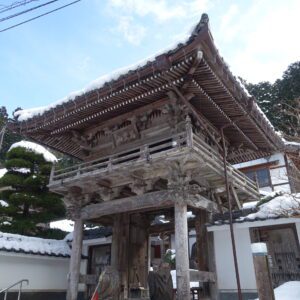

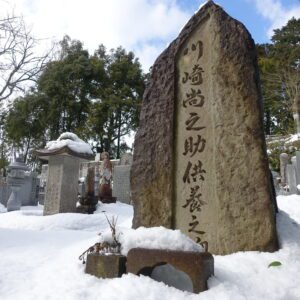

Izushi Sake Brewery, a brewery with a history of 1708, has a red-walled brewery, which is rare for a brewery. The representative brand of Izushi Sake Brewery, “Sasazuru,” is a nationally famous sake. 



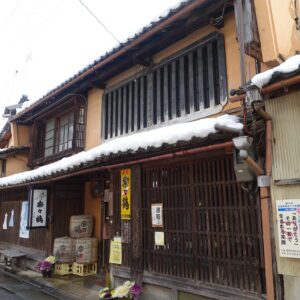

The main building of the former Fukutomi family residence, which was a wealthy merchant, was built in 1912. The main building is a two-story wooden townhouse building that still exists as it was when it was built.


The lanterns at the landing place at the foot of the Izushi River bridge are called “Oryu lanterns”. It is said to be named after the main character “Oryu” in the tragic love story of the Kamakura period.
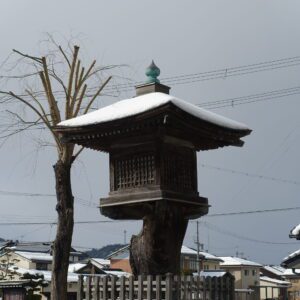

Eirakukan was built in 1901. It is the oldest theater hut in the Kinki region and the oldest existing theater building in Japan. It is an important tangible cultural property of Hyogo prefecture.
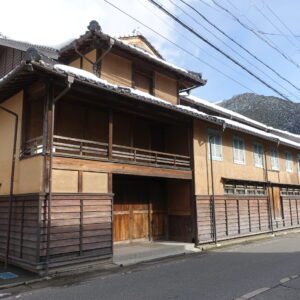

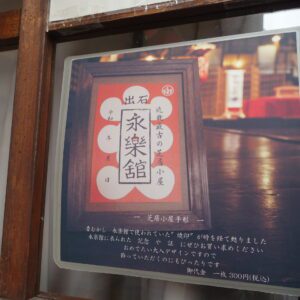

Hide Shrine was built in the early 16th century at the end of the Muromachi period. The main shrine has been designated as a national important cultural property because it retains the architectural techniques of the late Muromachi period.
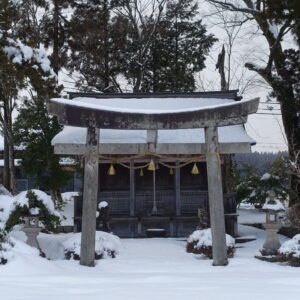

Meals
I had breakfast at Sasayama Castletown Hotel NIPPONIA. The breakfast using local ingredients such as “Yamanoimo (Japanese yam)”, which is a specialty of Tanba Sasayama, and Tajima beef was very delicious. It was a very satisfying breakfast.
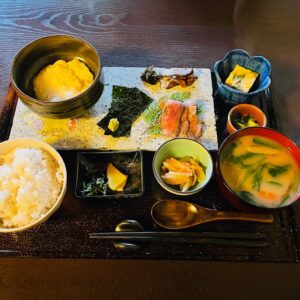

Especially, “Yamanoimo (Japanese yam)” was very delicious. “Yamanoimo” from Tanba Sasayama has a round shape and is also called Yamatoimo. Compared to yam, it is much more sticky and has a good flavor. In autumn and winter, the Tanba region may be filled with thick fog called Tanba fog due to the temperature difference. This climate with a large temperature difference grows delicious “Yamanoimo”.
I bought an ekiben “Buta meshi (Pork rice)” (Yen 1,100) at the restaurant “Yama no Eki” at Kaibara Station and ate it on the train to Yoka Station. “Buta meshi (Pork rice)” is an ekiben made by stir-frying “Tanba Pork” loin and adding Koshihikari rice, onions, and peppers from Tanba. I enjoyed the meal on the train because it went well with the sake from Houmei Sake Brewery that I bought in Tanba Sasayama City the day before.


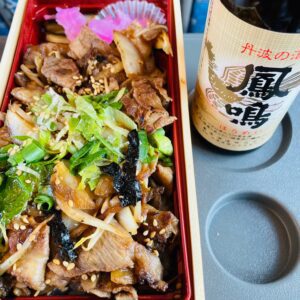

I arrived at Izushi and had “Izushi soba” at “Kanbei”. It is said that Masaaki Sengoku, who changed the country from the Ueda domain of Shinano province to the Izushi domain of Tajima province in 1706, brought a soba craftsman. Soba is also called “Izushi sara soba” because it is served on a small plate (sara) of Izushi ware.


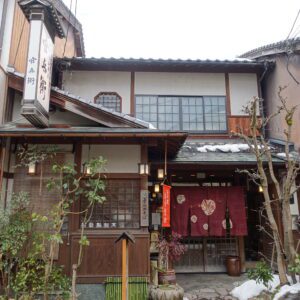

In Toyooka City, I had dinner at the sushi / cooking “Nakai“. “Nakai” is a restaurant that won the Michelin Guide Bib Gourmand in 2016. It is a well-known store in Toyooka City that mainly uses ingredients from the sea, mountains, and fields of Tajima and offers unique dishes.
First is the appetizer platter. Spring season vegetables such as rape blossoms and butterbur sprout and abalone were all very delicious, and I was very satisfied with the appetizer.
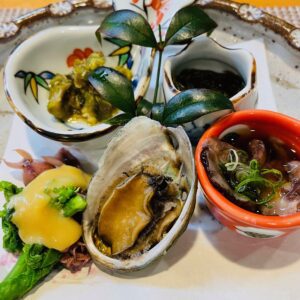

“Snow crab” is a typical winter taste of the Sea of Japan. By the way, snow crabs landed in the Sanin region (northern Hyogo prefecture, northern Kyoto prefecture, Tottori prefecture, Shimane prefecture) are called Matsuba crabs.
Recently, the catch of “Snow crab” has dropped sharply, and the price has soared around December 2021. However, due to the spread of the new coronavirus infection, “semi-state of emergency COVID-19 measures” have been implemented in Hyogo prefecture, and the number of tourists has dropped sharply, so the price has settled down and I can afford it. The “live snow crab” I ate this time was Yen 11,000 per crab.



The “live snow crab” I ate this time is a brand crab landed at Tsuiyama Port in Hyogo Prefecture.
I think the most delicious way to eat “live snow crab” is sashimi. When you eat it with sashimi, you can feel the sweet taste of “live snow crab” more clearly, and you will be surprised at its deliciousness. Boiled snow crabs often use frozen crabs, so I think it’s a waste to eat boiled snow crabs during the season.



Next, the grilled snow crab came out. Grilled snow crab is also fragrant and delicious, but it does not come true to the deliciousness of sashimi.



At “Nakai”, I also ordered pickled mackerel and wakame seaweed shabu-shabu. Both were very delicious. However, I was always impressed by the deliciousness of “live snow crab”, so the impression of pickled mackerel and wakame seaweed shabu-shabu was very little impression.


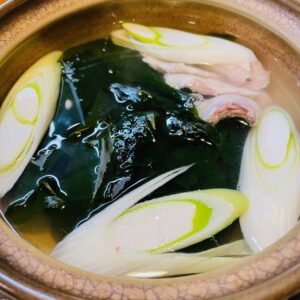

Important points
I didn’t have any problems on the second day of my trip.
7. February 25 (Friday) Day 3
Tourist spots
I took a taxi to Sakataru Shrine in the morning of February 25.
As the name suggests, Sakataru Shrine is a shrine related to sake. The god of worship is Sakamizuo no Mikoto and Sakamizume no Mikoto, the ancestor of Toji and the guardian deity of the sake brewer.
The main shrine of Sakataru Shrine was completed in 1449. The main shrine is designated as a national important cultural property because the design of the Muromachi period is valuable. However, I couldn’t take a closer look at the main shrine because it was protected by a covering roof and the deep snow in the precincts was to get close to the main shrine.
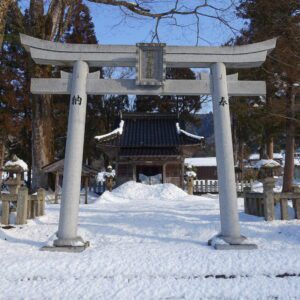

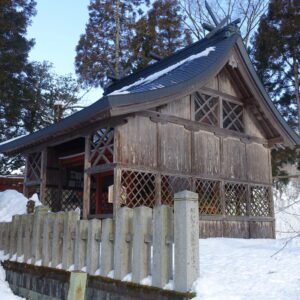

When I was walking to “Hyogo Park of the Oriental White Stork“, which is a 20-minute walk from Sakataru Shrine, I found a wild white stork in an ice-covered rice field. It is said to be a vigilant bird, but the white stork stayed still, even when I approached it to a distance of 20-30 meters.
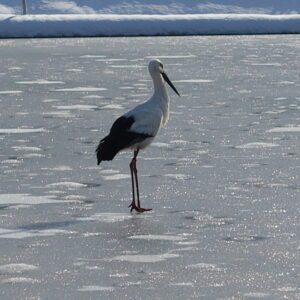

The stork is designated as a national special natural monument. It is a big bird that can reach up to 2m when both wings are spread.
“Hyogo Park of the Oriental White Stork” was opened in 1999 as a research institute that protects and proliferates white storks, a national special natural monument, and practices reintroduction to the wild. We can observe breeding white storks in the open area of the park.
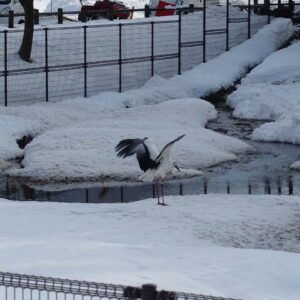

By 2019, 53 white storks were released outdoors after being bred in Hyogo Park of the Oriental White Stork, and now they are flying not only to Hyogo prefecture but also to 47 prefectures nationwide.
The mailbox at the entrance of “Hyogo Park of the Oriental White Stork” was shaped like a white stork sandwiching the mailbox.


Toyooka City was hit by the North Tajima Earthquake with a seismic intensity of 6 in 1925 (two years after the Great Kanto Earthquake). The earthquake killed 428 people, completely destroyed 1,733 houses, and partially destroyed 2,106 houses. After that, many buildings were built as “reconstruction architecture” for reconstruction, and those buildings still remain.
The “Toyooka City Hall Former Main Government Building (former Toyooka Town Hall)” built in 1927 is a building with beautiful white walls.
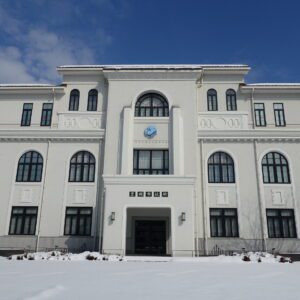

“Auberge Toyooka 1925” was built in 1934 as “Hyogo Agricultural and Industrial Bank Toyooka Branch”. It is a national tangible cultural property. “Auberge Toyooka 1925” is named after 1925, when the Great North Tajima Earthquake struck.
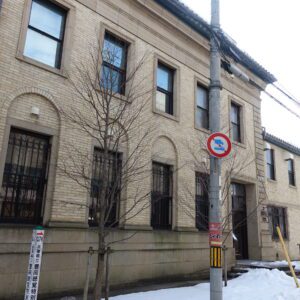

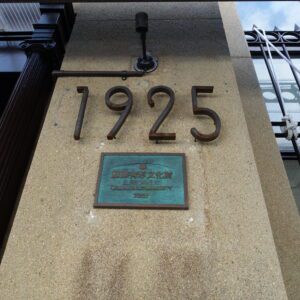

There are three reconstruction buildings on Saint-Stoke Avenue. It is one of the representative buildings of earthquake disaster reconstruction architecture.
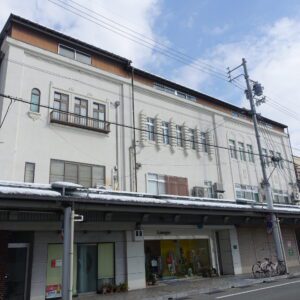

After lunch, I headed from Toyooka station to Tottori station.After arriving at Tottori Station, I checked in at the hotel and took a bus to the Tottori Castle Ruins and Jinpukaku.
Tottori Castle ruins are the ruins of a castle that originated from a mountain castle during the Warring States period. It has been selected as one of the 100 Fine Castles of Japan by the Japan Castle Association.
Tottori Castle is also a tragic castle where many people died of starvation due to the starvation tactics of Hideyoshi Hashiba (Hideyoshi Toyotomi). At the time of this starvation tactics, the castle owner, Kikkawa Tsuneie, opened the castle in exchange for Seppuku (Harakiri). There is a statue of Kikkawa Tsuneie in the immediate vicinity of Tottori Castle.
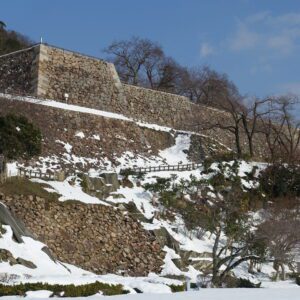



“Historic site Tottori Castle Ruins Taikoganaru” is a national designated historic site.
“Jinpukaku” is a Western-style building built on the ruins of a castle and is a national important cultural property. “Jinpukaku” was built in 1907 as the villa of the Ikeda clan, the lord of the Tottori domain. “Jinpukaku” was designed by architect Katayama Tokuma. He designed the current national treasure, the Guest House Akasaka Palace. “Jinpukaku” is a two-story white wooden tiled roof. The “spiral staircase” has no columns. It’s a wonderful curvaceous beauty.




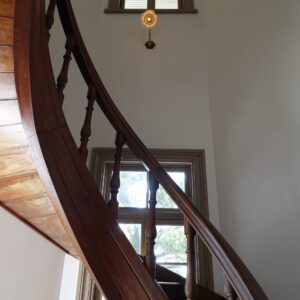

In “Jinpukaku”, the Kirin lion head used for the Shishimai (lion dance) that has been handed down from ancient times in Inaba Province (currently eastern Tottori Prefecture) was exhibited. The Shishimai using Kirin lion head have started at the Gongen Festival in 1650 when the first Tottori feudal lord, Mitsunaka Ikeda, built the Tottori Toshogu Shrine (Ouchidani Jinja). It has been designated as a national important intangible folk cultural property and has been designated as a Japanese heritage site as “Kirin no Machi“.
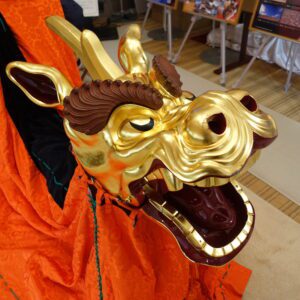

The Minoura family samurai gate is the nagayamon of the Minoura family who was a senior samurai of the Tottori domain. It is designated as a protected cultural property designated by Tottori City because it is valuable as the remains of the only samurai nagayamon that remains in Tottori.
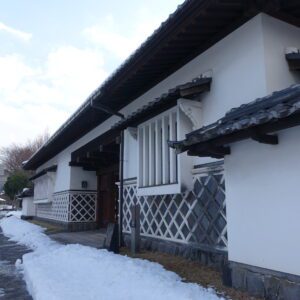

Tottori Toshogu Shrine (Ouchidani Jinja) was built in 1650 by the first Tottori feudal lord, Mitsunaka Ikeda, as a spirit of Nikko Toshogu. Mitsunaka Ikeda is the grandson of Terumasa Ikeda, the first feudal lord of the Himeji Domain in Harima, and the great-grandson of Ieyasu Tokugawa.
The four buildings of the main shrine, worship hall, heiden, and Karamon of Tottori Toshogu are national important cultural properties.
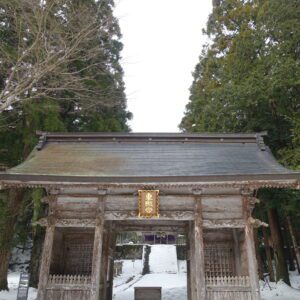

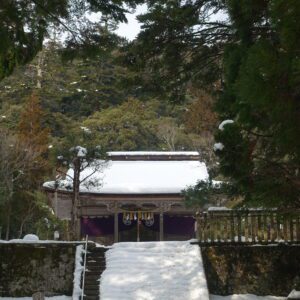

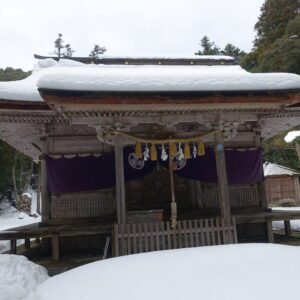

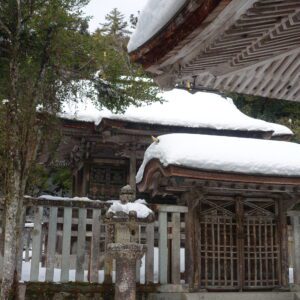

The Fukuda family is a family of pedigree who served as Oshoya (village headman) in the former Tsunoi village for 20 generations. The construction period of the Fukuda family residence is estimated to be from the end of the Muromachi period to the beginning of the Edo period, and it is the oldest residential building in Tottori prefecture. It is designated as a national important cultural property.

Meals
I had brunch at Oishiya Shokudo after finishing the walk in Toyooka city. Oishiya Shokudo is a Taishu Shokudo (cheap restaurant) that has been opened in front of Toyooka Station since the early Showa period. It’s open from 8am to 9pm, so I think it’s a popular Taishu Shokudo for people who arrive at Toyooka Station or depart from Toyooka Station.
I ordered “Oden” and “Crab bowl” at Oishiya Shokudo. “Oden” has been stewed in an oden pot, so it came out soon. It was a delicious “oden” with the taste soaked in the ingredients.
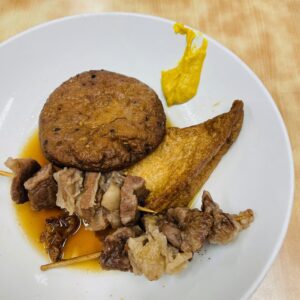

I waited for about 20 minutes until it came out after ordering the “Crab bowl”. The impression is that it took a long time. However, the taste of “crab bowl” was good. The boiled crab legs and eggs were exquisite.


I had dinner at “Aji-goyomi Anbe” after sightseeing in Tottori city. “Aji-goyomi Anbe” was one of the most delicious restaurants I have ever visited in Japan.
At “Aji-goyomi Anbe”, I ordered various sashimi first. The sashimi I ordered was Nodoguro (blackthroat seaperch) sashimi, Hatahata (Japanese sandfish) sashimi, and Sumi Ika (Japanese spineless cuttlefish) sashimi.
As you can see in the picture, the sashimi of blackthroat seaperch was the most delicious sashimi with fat.


I had Japanese sandfish sashimi for the first time in my life. It was very greasy and very delicious.



The sashimi of Sumi Ika (Japanese spineless cuttlefish) was also a very delicious sashimi with the unique sweetness that is characteristic of Japanese spineless cuttlefish. Also, I had squid legs of Japanese spineless cuttlefish with Korean-style spicy sauce. This was also the best.
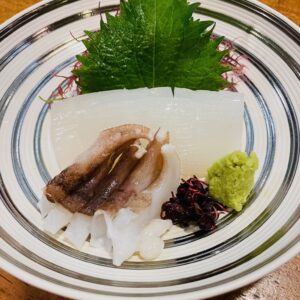

I ate “live snow crab” with sashimi and grilled. The sashimi of “live snow crab” was very sweet and delicious like yesterday. After all, I think the most delicious way to eat “live snow crab” is sashimi.



Grilled yaki crab is a way of grilling and eating by yourself. It was the best luxury to bake and eat crab miso in the shell. The owner taught me how to eat crab sashimi with the hot crab miso. When I actually tried it, this was also the best. It was too luxurious to eat.






After enjoying the “live snow crab”, I ordered sashimi of Mosa-ebi (black small shrimp), Nanbanzuke (marinated in a spicy sauce) of Spanish mackerel and white onions, and boiled liver of blackthroat seaperch.






I ate simmered liver of blackthroat seaperch for the first time. According to the owner, the restaurant can not collect a sufficient amount of liver for simmered liver unless it purchases a large amount of blackthroat seaperch. The simmered liver of blackthroat seaperch had a sticky texture peculiar to simmered liver, and the elegant fat of blackthroat seaperch was added, and it was an inspiring taste that goes well with sake.
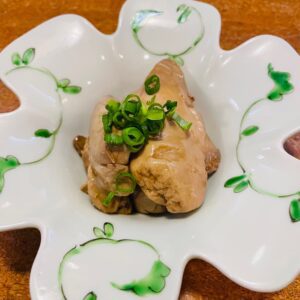

After having the best dinner at “Aji-goyomi Anbe”, I had Horumon-soba at Goen. Horumon-soba is a yakisoba with beef offal that is loved by locals in the eastern part of Tottori prefecture such as Tottori City.






Important points
As I wrote at the beginning, the “JR Sanin Line” from Kinosaki Onsen Station to Tottori Station was a one-man-operated train. Please note that it is difficult to understand how to get on and off.
There are buses from Toyooka Station to “Hyogo Park of the Oriental White Stork”, but the number is quite small. It is convenient to take a taxi because you can go by taxi for less than Yen 2,000 one way.
Tottori city sightseeing has intervals between each sightseeing spot. I walked around the city except for the Fukuda family residence, but it takes more than 20 minutes between sightseeing spots. On the other hand, bus routes are not suitable for traveling between tourist attractions. Those who have difficulty walking may have no choice but to call a taxi.
8. February 26 (Saturday) Day 4
Tourist spots
Tottori Sand Dunes is a tourist destination that represents Tottori prefecture, and I have visited it several times. However, this was my first winter visit. The Tottori Sand Dunes is a vast sand dune 2.4km north-south and 16km east-west. It is the largest sand dune in Japan that can be visited. It has been selected as a national natural monument.
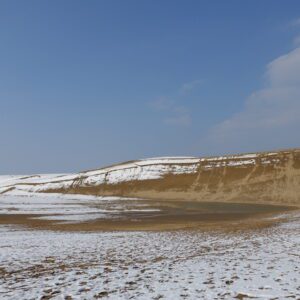

There is also an oasis near the sand dunes called “the Umanose (back of a horse)”.
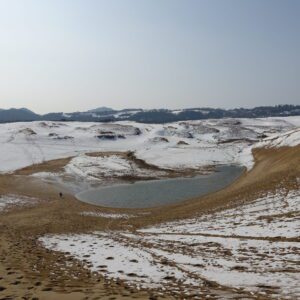

There was no snow on the dunes on the sea side.


There are also camels for tourists in the Tottori Sand Dunes. Camels were brought to the Tottori Sand Dunes in 1960.
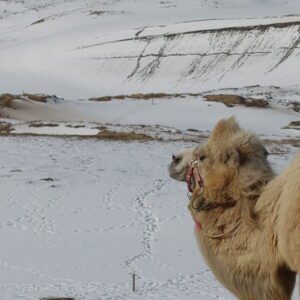

Tottori Station is not only the departure and arrival station of JR West, but also the Wakasa Railway. The vehicle of Wakasa Railway is a one-car train such as the green “Wakasa” and the red “Yazu”, but it has the exterior and interior design of the sightseeing train. In addition, there are blue “Showa” and motorcycle “Hayabusa” wrapping trains.




“Detective Conan Train” was also stopped at Tottori Station. Tottori Prefecture founded “Manga Kingdom Tottori” in 2012. Tottori Prefecture has a large number of manga artists such as Shigeru Mizuki of “Gegege no Kitaro” (raised in Sakaiminato City), Jiro Taniguchi of “To a Faraway Town” and “A Journal of My Father” (born in Tottori City), and Takemasa Aoyama of “Detective Conan” (Daiei-cho, now Hokuei-cho). “Manga Kingdom Tottori” was created by Tottori Prefecture, which produced many manga artists, for the purpose of promoting tourism, industry, and human resources development.
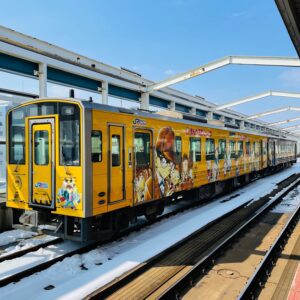

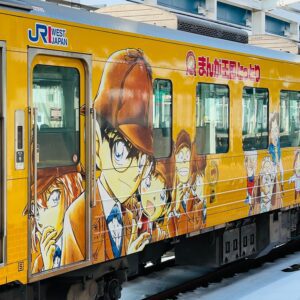

At Kurayoshi Station, there is a large panel of “Hinabita ♪”. Since Kuranogawa City and Kurayoshi City, which are the setting of “Hinabita ♪”, have much in common in terms of historical background and scenery, they entered into a sister city tie-up in April 2016. In addition, Kurayoshi City was the first in Japan to win the “Japanese Anime Sanctuary 88” certification plate sponsored by the Anime Tourism Association.
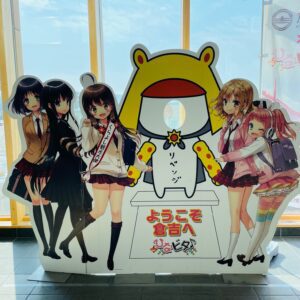

The “Kurayoshi City Uchibuki Tamagawa Traditional Buildings Preservation District” has been designated as a National Important Preservation Districts for Groups of Traditional Buildings, centering on Kurayoshi Shirakabe Dozo-gun. The building age consists of several buildings in the late Edo period, about 30% in the middle and late Meiji period, about 20% in the Taisho period, and about 20% in the early Showa period.




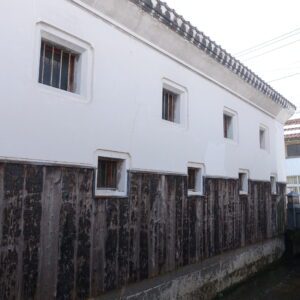

The Kurayoshi Daitenkai (former Kurayoshi Branch of the Third National Bank), which has an unusual two-story structure, is a national registered tangible cultural property. It was built in 1908.
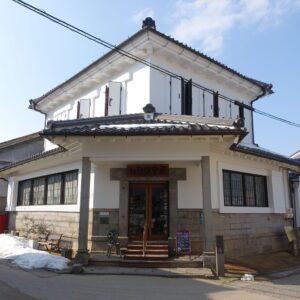

The place in the picture below was used in the scene where Tora-san and Kumiko Goto, who played Madonna, met in “Otoko wa Tsuraiyo Torajiro’s Kokuhaku (Confession)”.
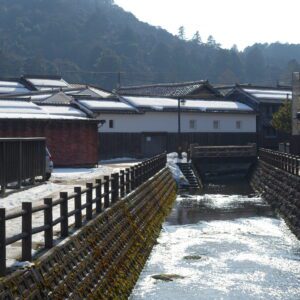

In addition to Kurayoshi Shirakabe Dozo-gun, there are many retro Showa buildings in Kurayoshi, and it was a fun city to walk around. I think it’s a city where you can immerse yourself in the nostalgic Showa atmosphere with the signboards of the stores.


The public bath, Taisha-yu, is a national registered tangible cultural property. It is the oldest existing public bath in Tottori prefecture, which opened around 1907.
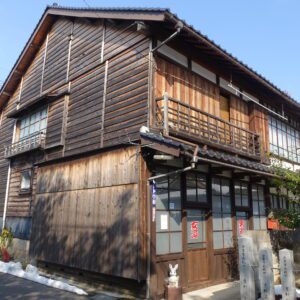

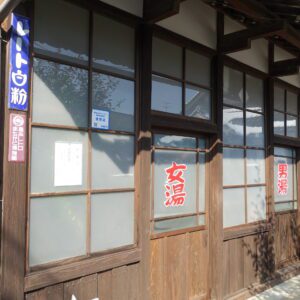

There were many other buildings in Kurayoshi with a nostalgic atmosphere.
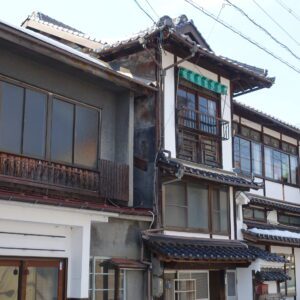

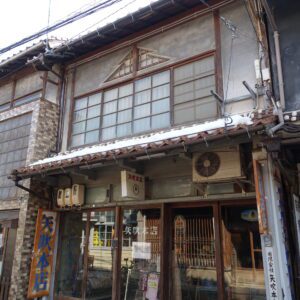

The building in the photo below was built in 1931 as the Kurayoshi branch of the Japan Industrial Savings Bank. It is a Western-style building that is rare in Kurayoshi.
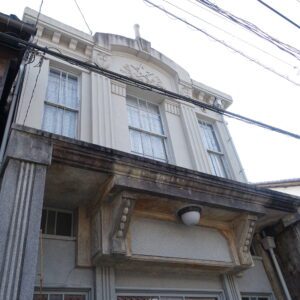

The Toyoda family residence is a two-story wooden house built in 1900 and is a traditional Machiya style in Kurayoshi. It is a national registered tangible cultural property. The inside of the Toyoda family’s house and the inner garden are also wonderful. If you go upstairs away from the main building, you will find a red tile storehouse built in 1771.


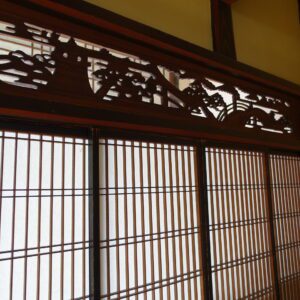

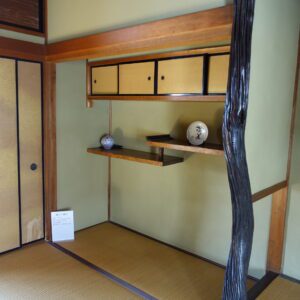

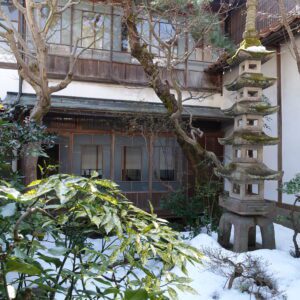



Kurayoshi Yodoya is the oldest existing Machiya building in Kurayoshi City, built in 1760. The Makita family with the name “Yodoya” was a representative merchant house in Kurayoshi.
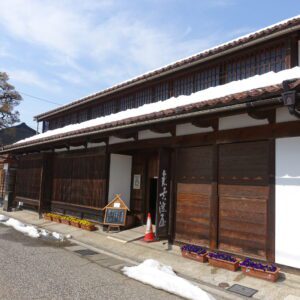

The interior of Kurayoshi Yodoya is very spectacular. I felt like I could get a glimpse of a part of wealthy merchant.
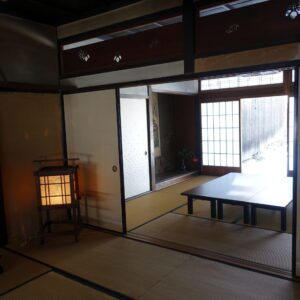

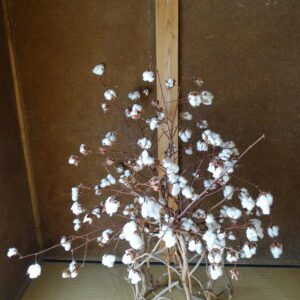



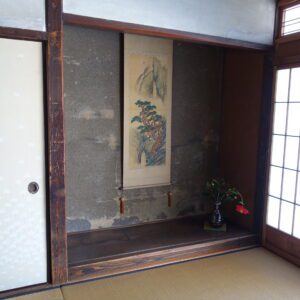

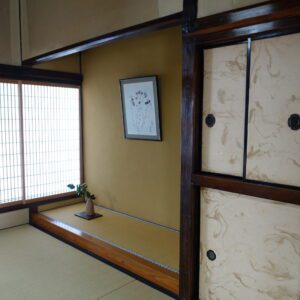

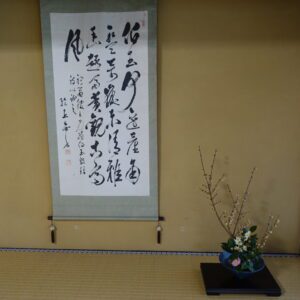





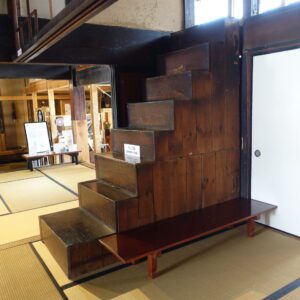

I went to Hasedera Temple, which is the only national important cultural property in Kurayoshi City. It was founded in 721 in the Nara period with the opening of Hodo.

The main hall, which was rebuilt during the Muromachi period (1336-1573), is a “Kakezukuri” building that accommodates steep slopes. “Kakezukuri” is an architectural style in which a building is built on a land with a large height difference such as a cliff by fixing the underfloor with long pillars. “Kakezukuri” is famous for Kiyomizu-dera Temple in Kyoto.
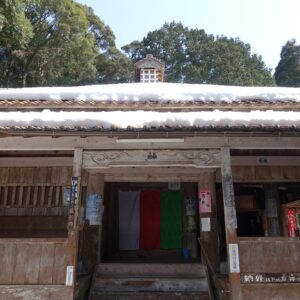

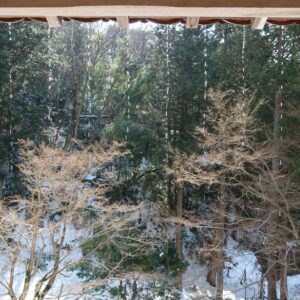

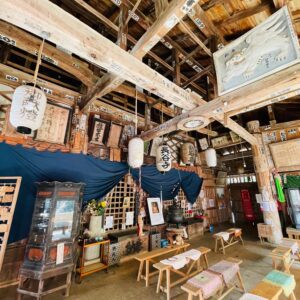

There is Platform 0 where the Sakai Line departs and arrives at Yonago Station. JR west operates the “Kitarou Train” because it is the place where the manga artist Shigeru Mizuki grew up in Sakaiminato City. The “Sunakake Baba” train that was stopped this time.


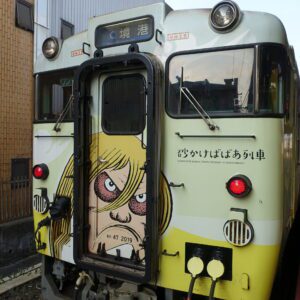

Although it is a “Sunakake Baba” train, many characters that appear in “GeGeGe no Kitaro” such as Kitaro, Neko Musume, and Medama no Oyaji are drawn on the side of the train.


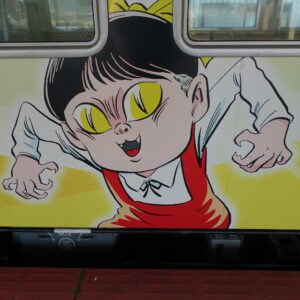

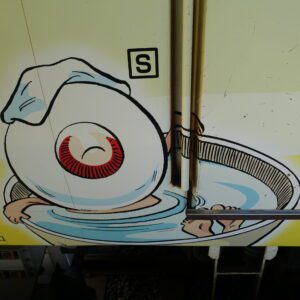

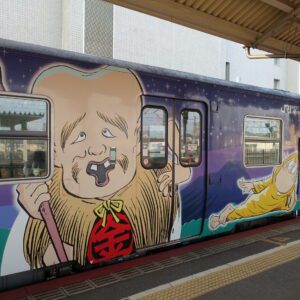

When you leave Yonago Station, you will find “Dandan Square”. The square has a monument to the birthplace of the San’in Railway and a monument that closely resembles Galaxy Express 999. “Dandan” is a dialect of Yonago and means “thank you”.
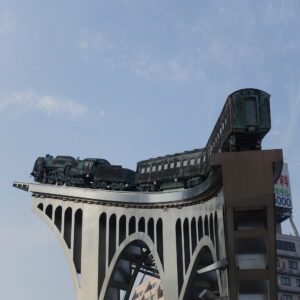

Meals
“Kitaro Beer” is a Kitaro label version of the popular craft beer “Daisen G Beer“. “Daisen G Beer” is a beer manufactured by Daisen Brewery. The Kitaro label is affixed, but the contents are “Daisen G Beer”, so it was a very delicious beer.
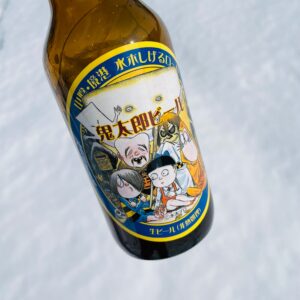

“20th century pear Chuhai” is a pear chu-hai that uses 11% of Tottori’s 20th century pear juice. It is produced by Hayashi Kentaro Shoten in Tottori City. When I tried “20th century pear Chu-hai”, it tastes like 20th century pear.
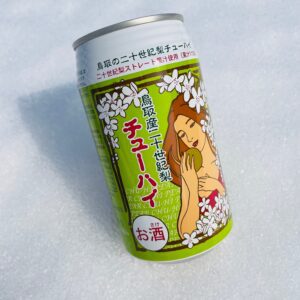

I had the famous ekiben “Kani (crab) Sushi” of Tottori Station and the local sake “Tabi (Travel) Sake No. 39 Tottori Sand Dunes” on the train from Tottori Station to Kurayoshi Station.
Abe Tottori-do’s ekiben “Kani Sushi” is a long-selling ekiben that started selling 70 years ago in 1952. It is also the first “Kani Sushi” sold in Japan.
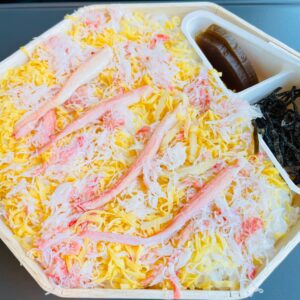

“Tabi Sake No.39 Tottori Sand Dunes” is a sake produced by “Nakagawa Sake Brewery”, which makes Tottori’s local sake “Goriki”. “Tabi Sake” is a series of sake made under the concept that “there is sake that you can’t drink without traveling” and you can only buy it locally.
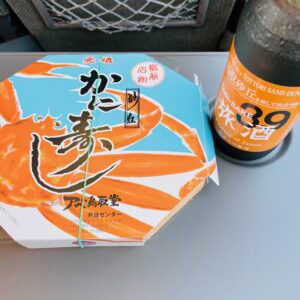

Arriving at Kurayoshi Station, I drank the IPA of the craft beer “BREW LAB KURAYOSHI” produced in Kurayoshi City.
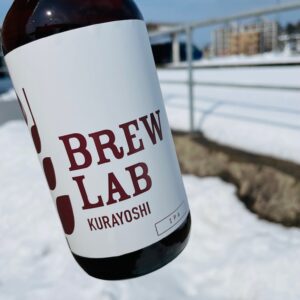

While walking around Kurayoshi city, I found a store of “BREW LAB KURAYOSHI” and drank pale ale. When I asked the store, “BREW LAB KURAYOSHI” was a company that was just established in May 2019, and the brewery was opened in August 2020.


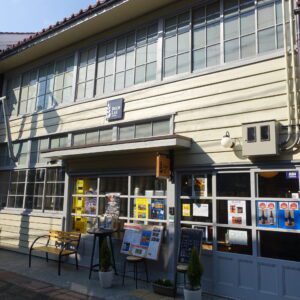

After drinking a delicious beer at “BREW LAB KURAYOSHI”, I stopped by the sake brewery “Gensui Shuzo” in Kurayoshi City. At “Gensui Shuzo”, “BREW LAB KURAYOSHI” sold “Sake kasu (sake lees) brew” made from “Gensui Shuzo” sake lees, so I bought it and drank it.
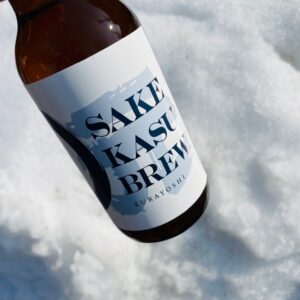



On the train from Kurayoshi Station to Yonago Station, I drank the pure malt whiskey “Kurayoshi” produced in Kurayoshi City with “Gegege’s Medama Oyaji Water”. In addition to the beer, sake, and whiskey I drank, there is even a “Kurayoshi Winery” in Kurayoshi City.
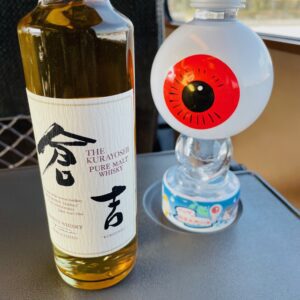



After arriving at Yonago Station, I had dinner at “Washoku Izakaya Shunmon”, which was near the hotel. I ordered the famous sashimi platter (shiro-ika, sagoshi, yellowtail), pickled scallion, lever “Shigureni” of John Dory, seasonal fish “Namero”, grilled white onion, crab miso, and “Hamada no Akaten”. All the meals I ordered were delicious and satisfying.
The shiro-ika that was in the famous sashimi platter is swordtip squid. The fishing season is from June to November, which is the representative summer taste of Tottori prefecture, but the shiro-ika I ate in February was also sweet and delicious enough.



I ate the lever Shigureni of John Dory for the first time. Shigureni is seafood that has been cooked in soy sauce and mirin. It was a very delicious liver Shigureni. The “Namero” of seasonal fish was also delicious.
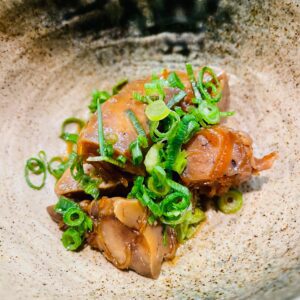

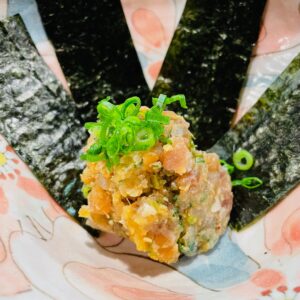

I had the grilled white onion by cutting it with scissors and dipping it in grilled miso. White onions are cultivated mainly in the sandy fields of the Yumigahama Peninsula between Yonago and Sakaiminato. There is also a branded white onion called “Hakushu Bijin” (shipping time: December-February).
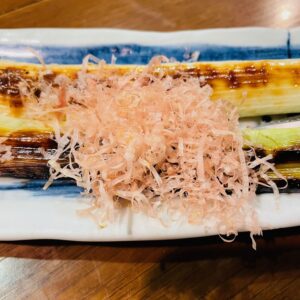



I have loved crab miso since I was a kid. The amount of crab miso at “Washoku Izakaya Shunmon” was very large and I was very satisfied. I think it was about three times as much as the amount of crab miso I ordered at an izakaya in Tokyo. It was a delicious crab miso that goes well with local sake.


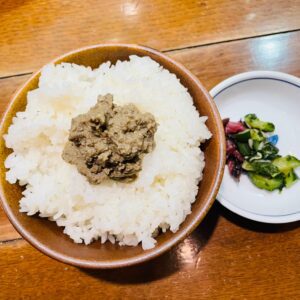

I was quite full, but I ate beef bone ramen, which is a local gourmet in Tottori prefecture. Beef bone ramen is a ramen that takes soup based on beef bones. Tottori Prefecture is a region where livestock farming in Daisen, especially cattle production, is high. The beginning of beef bone ramen is to make ramen by using the surplus beef bones as soup.



Important points
I stayed at Hotel Alpha-One Yonago on the 4th day of the trip, and I had to insert the key to turn on the lights and power of the room. I was in trouble because I couldn’t charge electronic devices such as smartphones when I was out. At hotels like “Hotel Alpha-One Yonago”, it is difficult to charge, so we need to bring a mobile battery.
9. February 27 (Sunday) Day 5
Tourist spots
I took a walk in Yonago city on the morning of February 27. First, I went to the Yonago Castle Ruins.
Yonago Castle once had a five-storied castle tower and a four-storied turret, and was called “the best castle in the Sanin region.” It is said that Yonago Castle started around 1591 when Kikkawa Hiroie built a castle on Minatoyama at an altitude of about 90m. Honmaru, Ninomaru, etc. are designated as national historic sites.
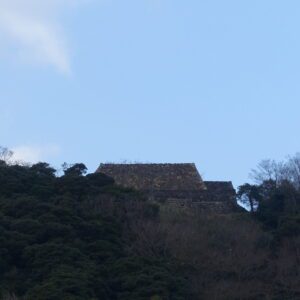



I went to Kamo Shrine Tenmangu, which is about a 5-minute walk from the Yonago Castle Ruins. Kamo Shrine Tenmangu is a shrine that originated in the place named Yonago.
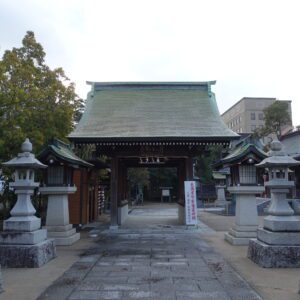

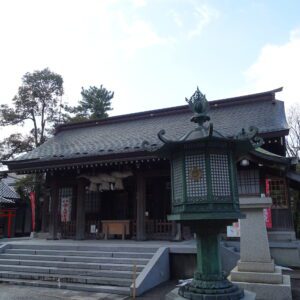

The Goto family residence is a national important cultural property. The inside of the building is not open to the public.


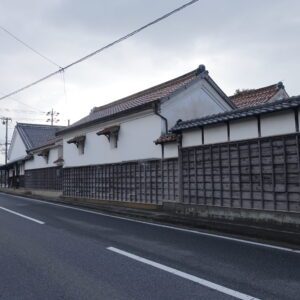

White-walled storehouses are lined up along the former Kamo River, where the Goto family residence is located. It is a remnant of the water transportation of rice etc. in Yonago, which prospered as the largest commercial city in the Sanin region. Since there is a legend that Kappa lived in the former Kamo River during the Edo period, there is also a statue of Shigeru Mizuki’s manga “Kappa no Sanpei”.
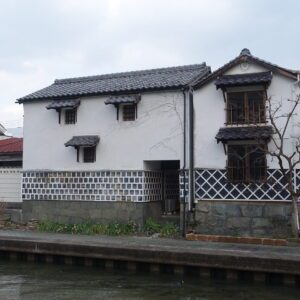

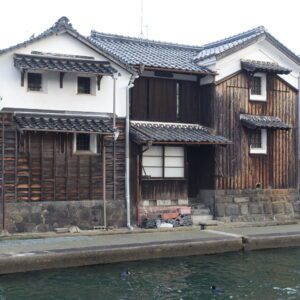



The former Yonago City Hall is about a 5-minute walk from the former Kamo River. Built in 1930. It is a tangible cultural property of Yonago City.
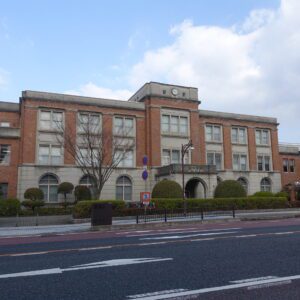

Yakumo Honjin (Kowake family residence) is located in Shinjicho, which prospered as a post town, and was rebuilt in 1733. 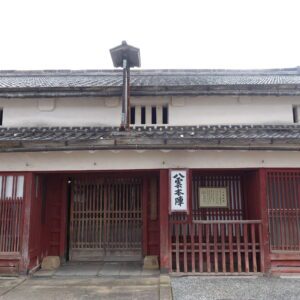

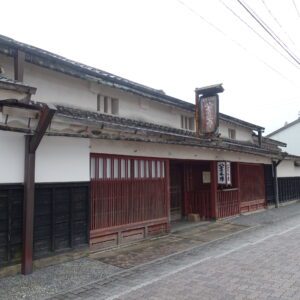

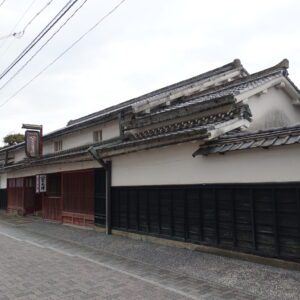

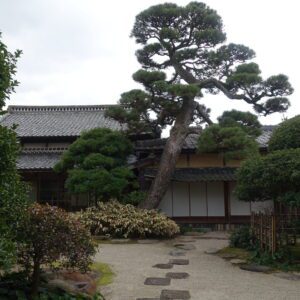

Yakumo Honjin consists of a vast building and garden with more than 40 rooms on a site of about 4,000 square meters. Many guests such as the Matsue feudal lord, Emperor Taisho, and Emperor Showa visited.
Yakumo Honjin is a national important cultural property. The inside of Yakumo Honjin was very impressive. In each room, wonderful arts and crafts such as hanging scrolls, folding screens and tea utensils from the Kowake family are exhibited.


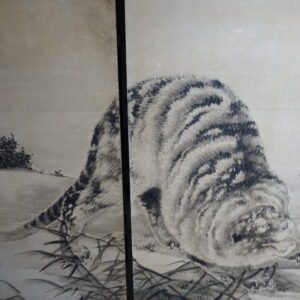



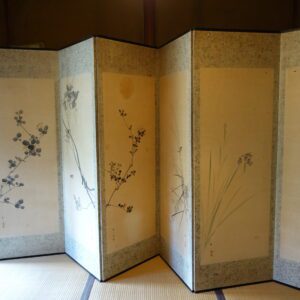

The main shrine of Kamosu Shrine is the oldest Taisha-zukuri in Japan and is a national treasure. The structure of Taisha-zukuri is digging pillar, gabled structure, and Tsumairi. It was built after the middle of the Heian period (794-1185), and the current shrine was rebuilt in 1583.
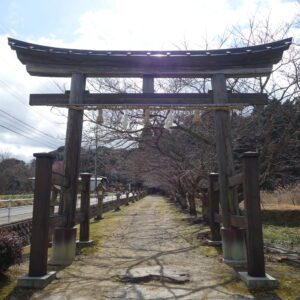

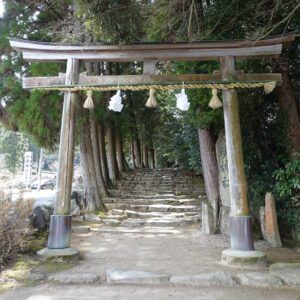

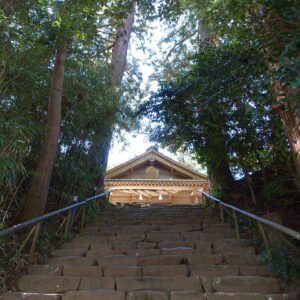

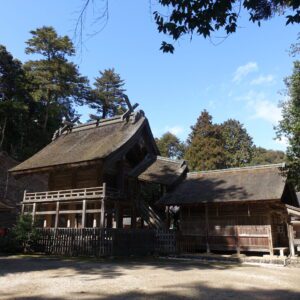

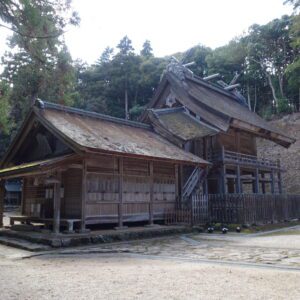

The main shrine of Kifune Inari Shrine, which is the subsidiary shrines of Kamosu Shrine, is a national important cultural property.
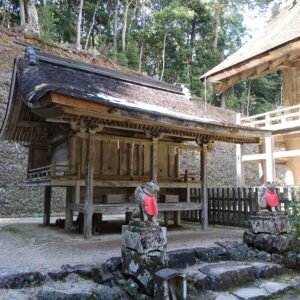

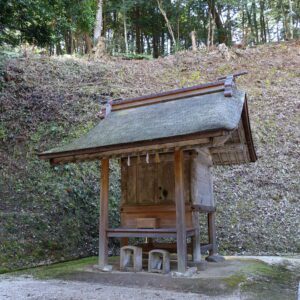

The precincts had a very mysterious atmosphere with a dignified and commanding atmosphere. I felt some spiritual energy. It is a popular shrine as a place with spiritual energy.
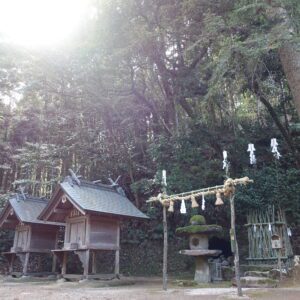

Matsue Castle is one of the existing castle towers with only 12 castles remaining nationwide. Of the 12 existing castle towers, there are only five national treasures: Matsue Castle, Himeji Castle, Hikone Castle, Matsumoto Castle, and Inuyama Castle.
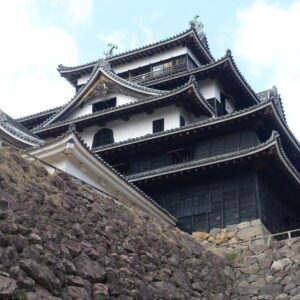



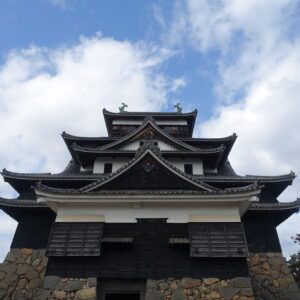

Kounkaku was built in 1903. Initially, it was built for the Emperor Meiji to stay, but it didn’t happen. However, it became an accommodation when Prince Yoshihito (later Emperor Taisho) Sanin visits in 1907. Kounkaku is a tangible cultural property of Shimane Prefecture.


Jozan Inari Shrine is located on the grounds of Matsue Castle. Horan-Enya, which is held once every 10 years, is Shikinen Shinkousai Festival of Jozan Inari Shrine. “Shinkousai Festival” means that God goes to another place. The next Horan-Enya is scheduled for 2029.


There are hundreds of stone foxes at Jozan Inari Shrine. This was my second visit. Personally, I felt it was a very mysterious shrine this time as well as last time.
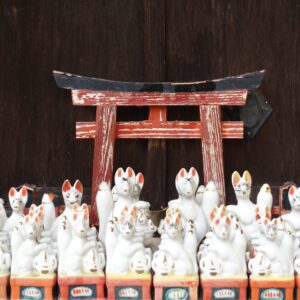

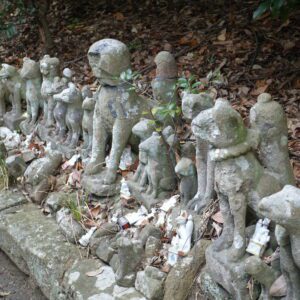



Karakoro Art Studio is a craft museum and commercial facility that was reopened in 2000 by renewing the former Matsue branch of the Bank of Japan. The former Matsue branch of the Bank of Japan was built in 1938 and is a national tangible cultural property.
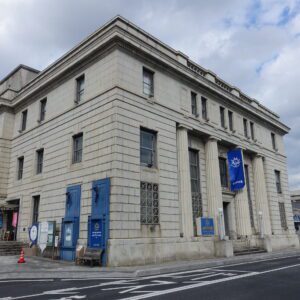



Yuushien is a Japanese garden with a pond in the centre on Daikon Island in Nakaumi. It opened in 1975. The soil rich in nutrients is ideal for peony cultivation, and peony cultivation, which started about 300 years ago, now accounts for more than 80% of Japan’s total production and is also exported overseas.
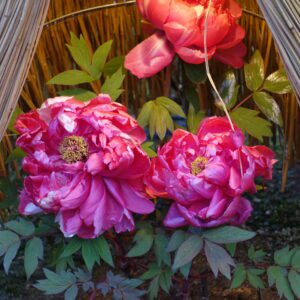

Originally, the best time to see peony is from late April to mid-May, but there is a peony hall where you can appreciate peony in full bloom all year round by adjusting the temperature and humidity. You can also see the “Kan-botan (peony in winter)” variety that blooms outdoors even in winter.
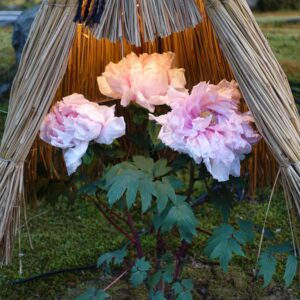

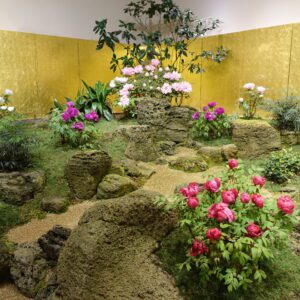



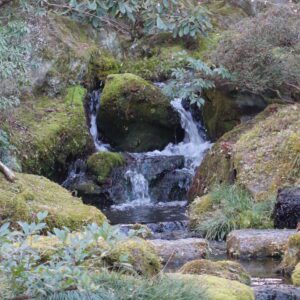

Since I went to Yuushien in the evening, I could see the illuminated garden. The illuminated garden was very beautiful and crowded with many people.
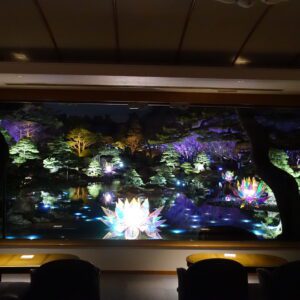

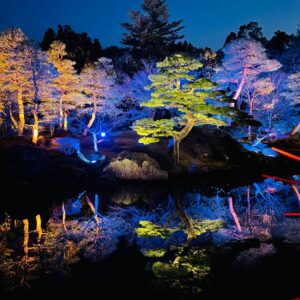



Peony collaboration with the flower arrangement artist Shogo Kariyazaki was also held. The work with the theme of Hanafuda (Japanese playing cards) was wonderful.
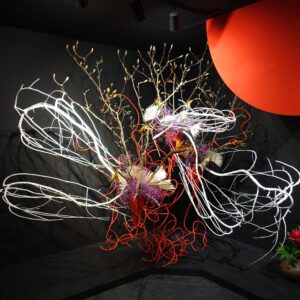

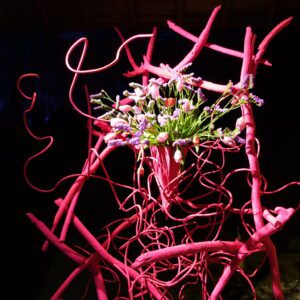

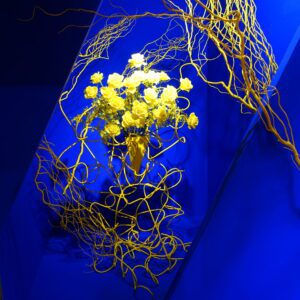

Yonago Kitaro Airport has many Kitaro objects as the name suggests. It was fun just looking at the Kitaro objects.
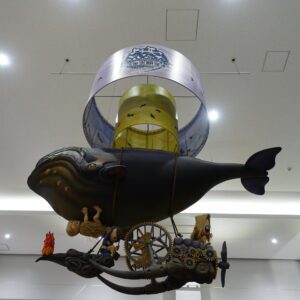

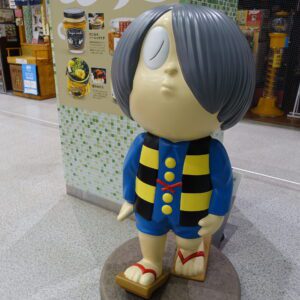

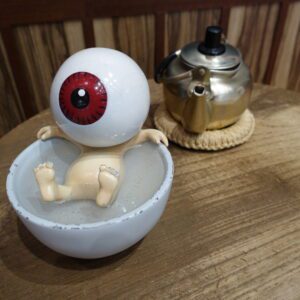

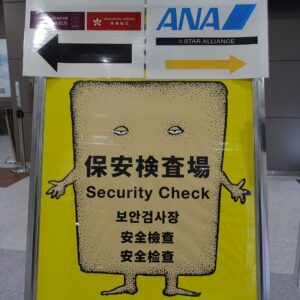

Meals
I bought the ekiben “Gozaemon Bento”, “Tofu Chikuwa”, and “Ago-noyaki” and ate them on the train from Yonago Station to Shinji Station. “Gozaemon Bento” (Yen 1,400) is a luxurious bento that contains Sanin’s famous Gozaemon sushi, Daisen Okowa, and crab chirashi-zushi. Gozaemon sushi is pressed sushi made with mackerel, conger eel, and crab, etc. Gozaemon Sushi is a famous pressed sushi that is also sold at Tokyo Station, Kabukiza Theater in Tokyo, and Nihombashi Mitsukoshi Main Store.





I had “Izumo soba” at Ichibata Department Store “Ippuku” near Matsue Station for a late lunch before going to Yuushien. “Izumo soba” is one of the three major soba noodles in Japan (the other two are Wanko soba and Togakushi soba).



I drank Matsue’s craft beer “Beer Hearn” at Sasakiya. Sasakiya is a souvenir shop in the station building of Matsue Station, but you can drink local sake and craft beer while standing. 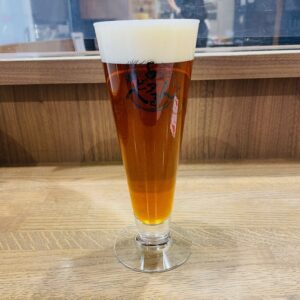

Important points
The problem with Yuushien is that there is no public transportation to Yonago Kitaro Airport. On the other hand, the last bus bound for Matsue Station departs from Yatsukacho / Yuushien entrance at 18:50, so in winter you can manage to get to Matsue Station after enjoying the illumination.
Note: The departure / arrival times, fares of transportation, admission fees, meal fees, etc. listed in the text are as of the time of writing the BLOG. Please check for yourself when you go on a trip as it may change in the future.
